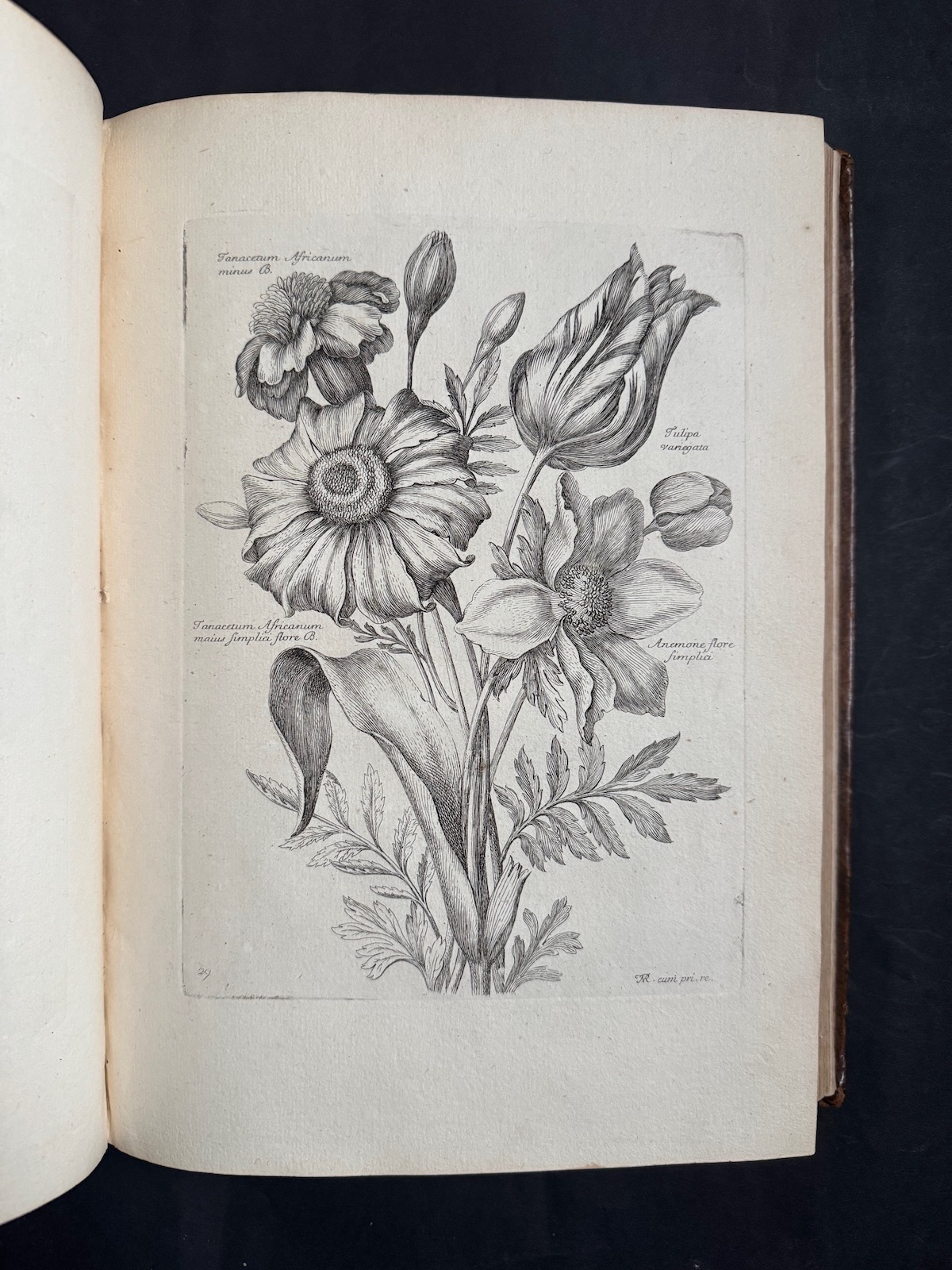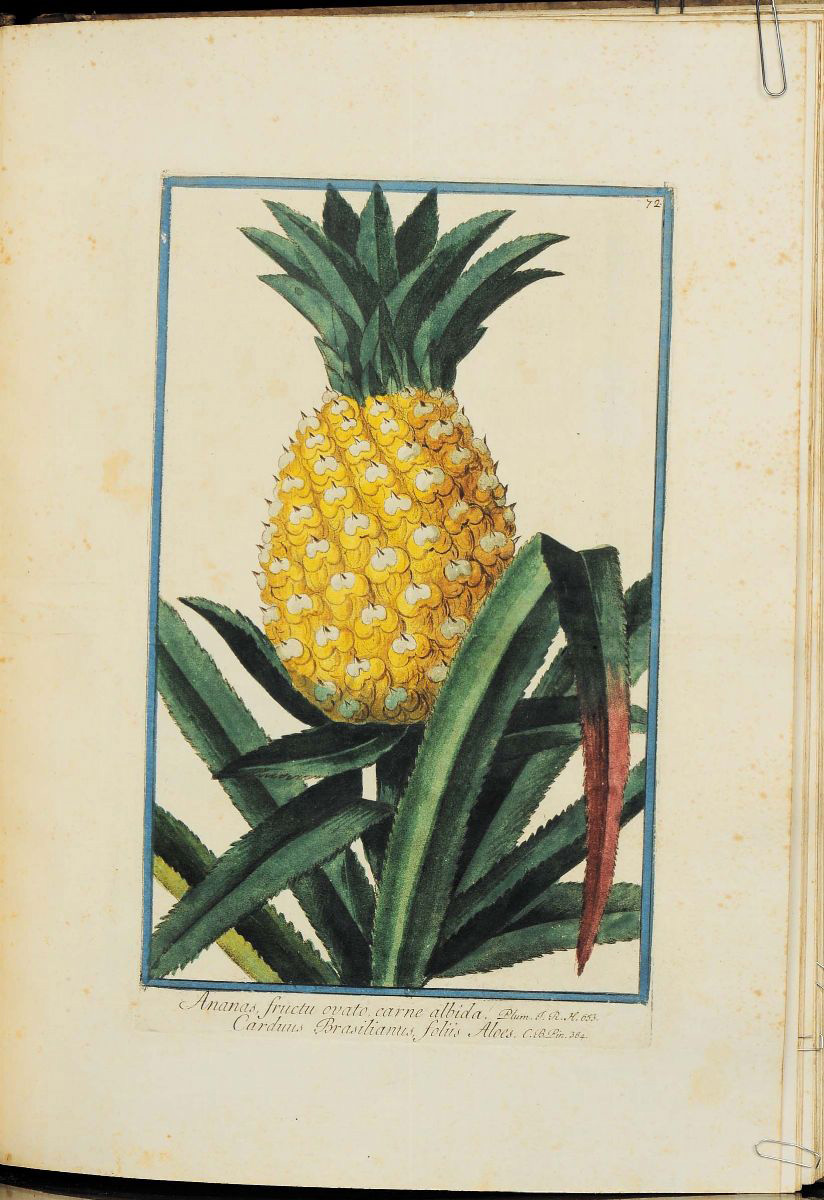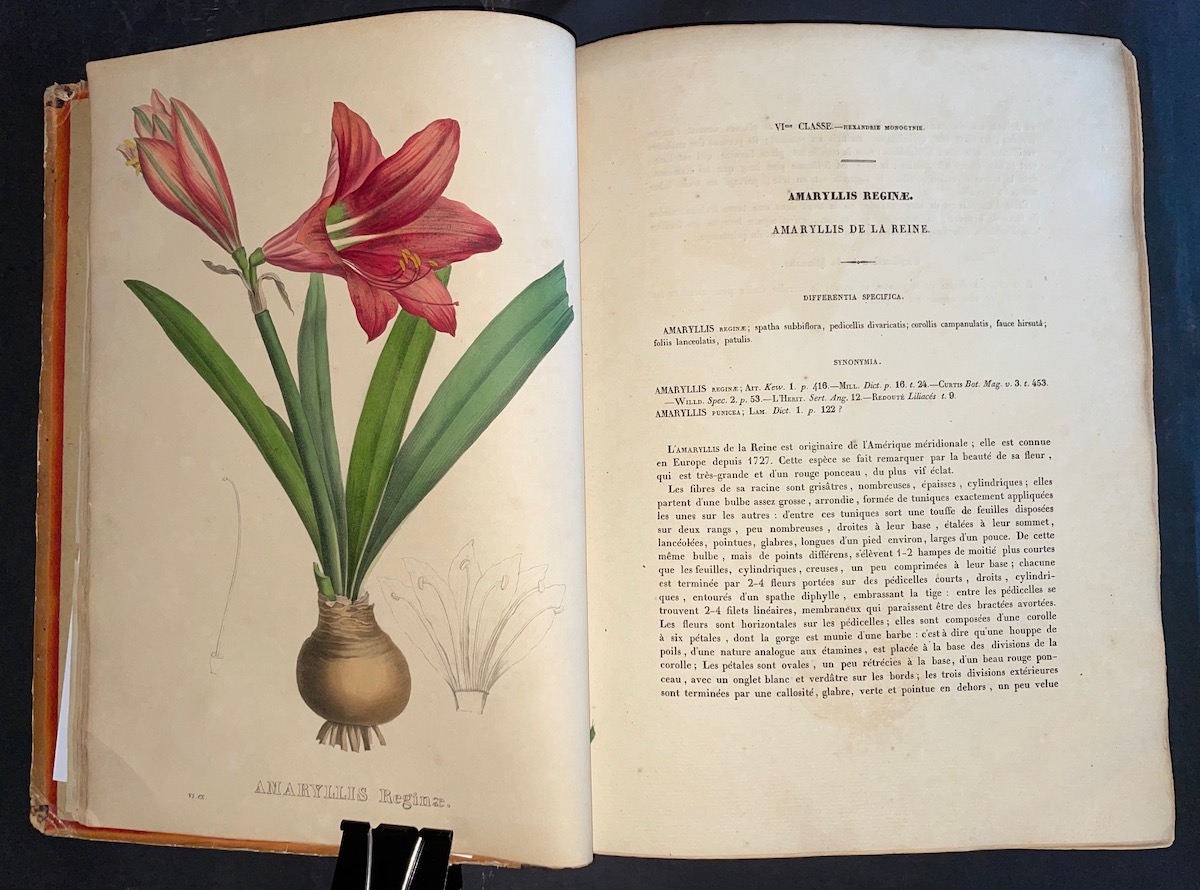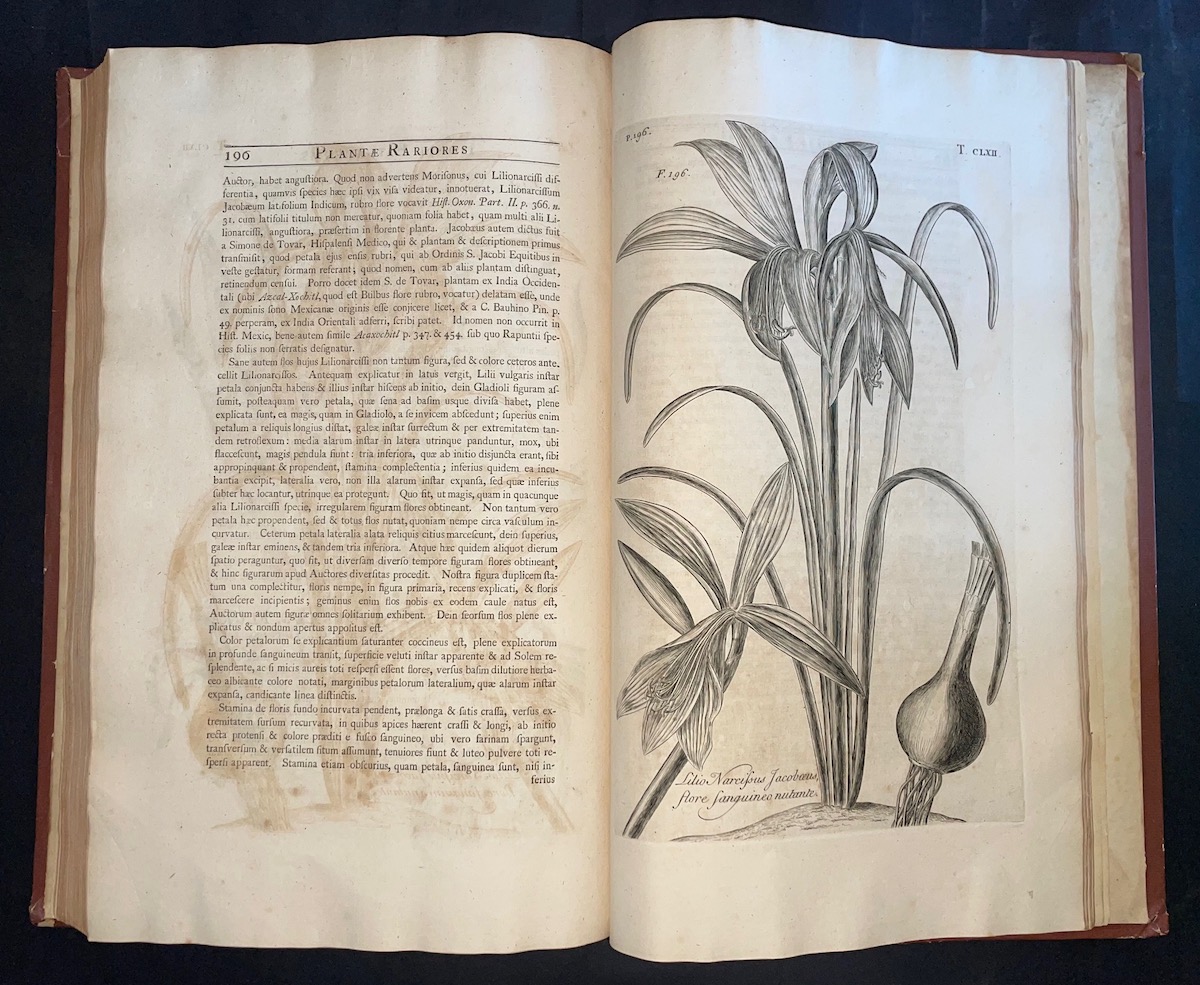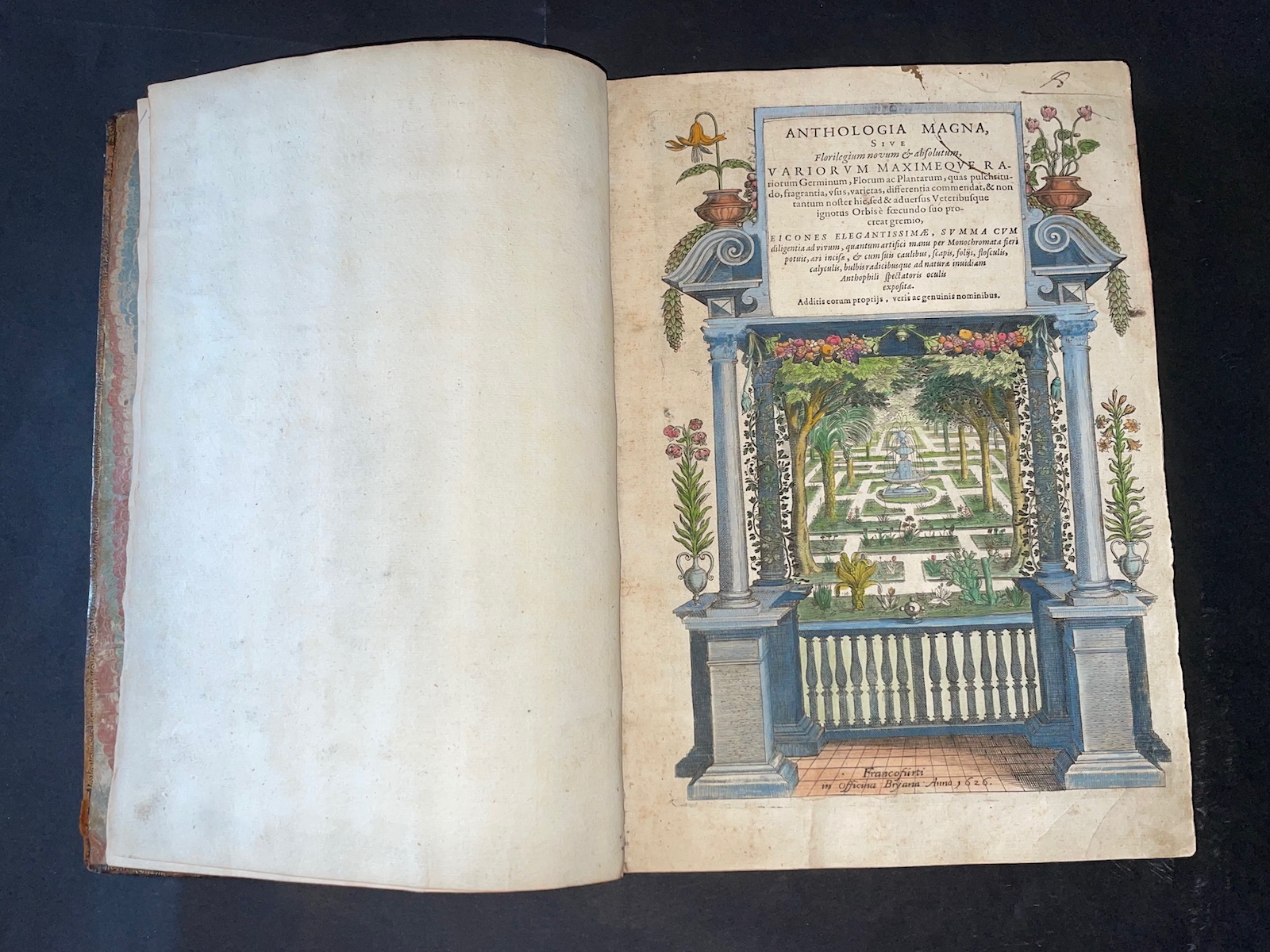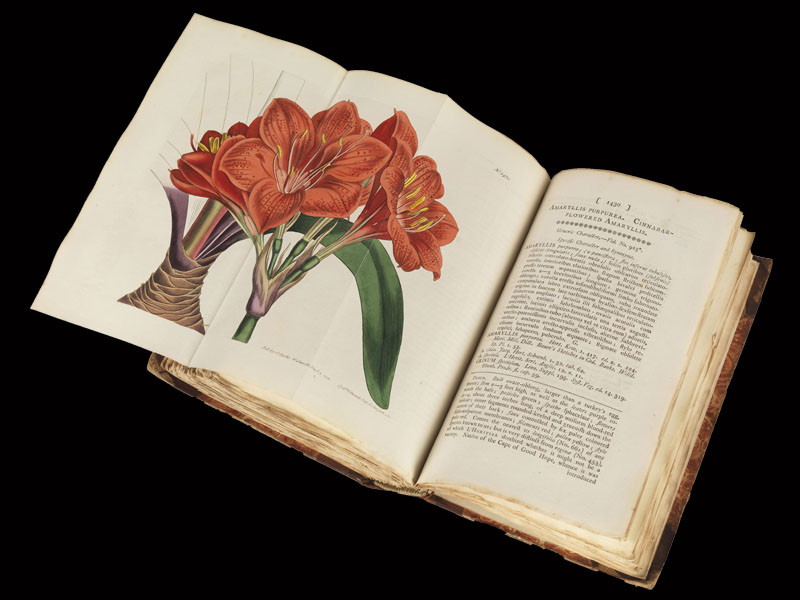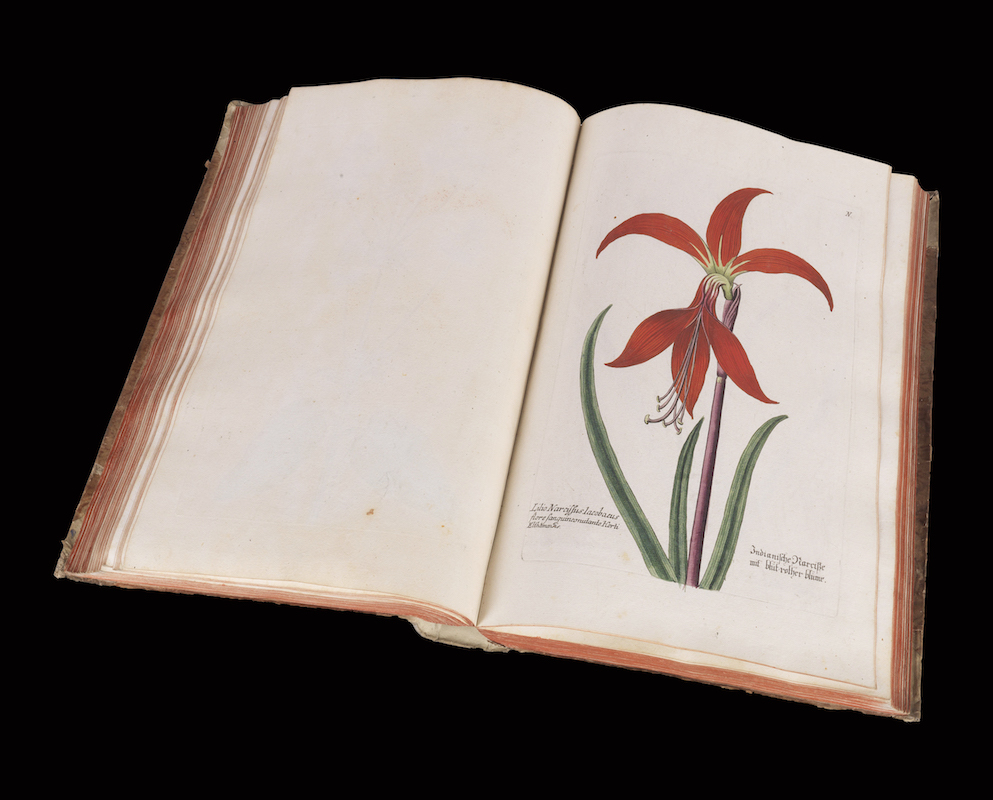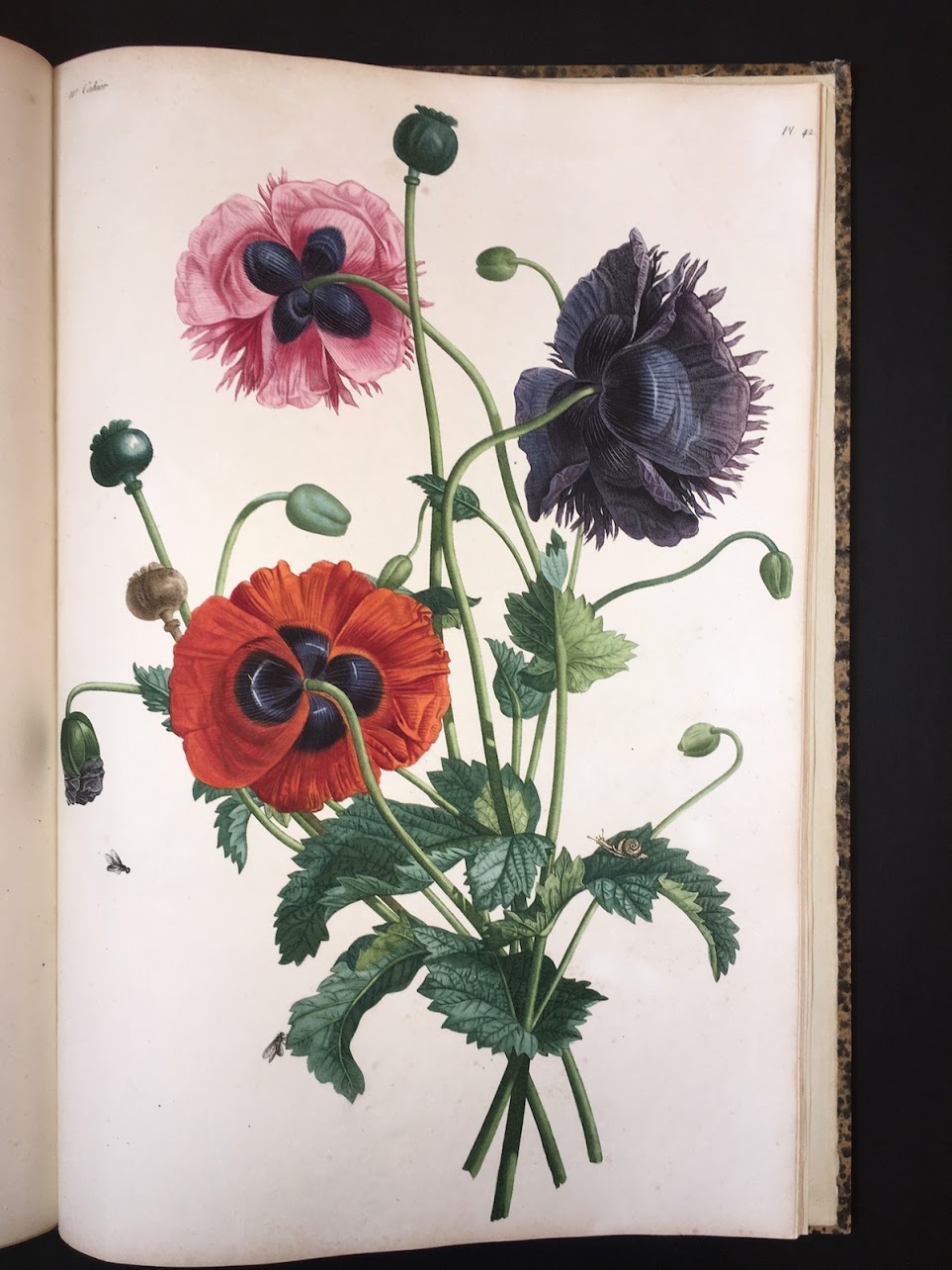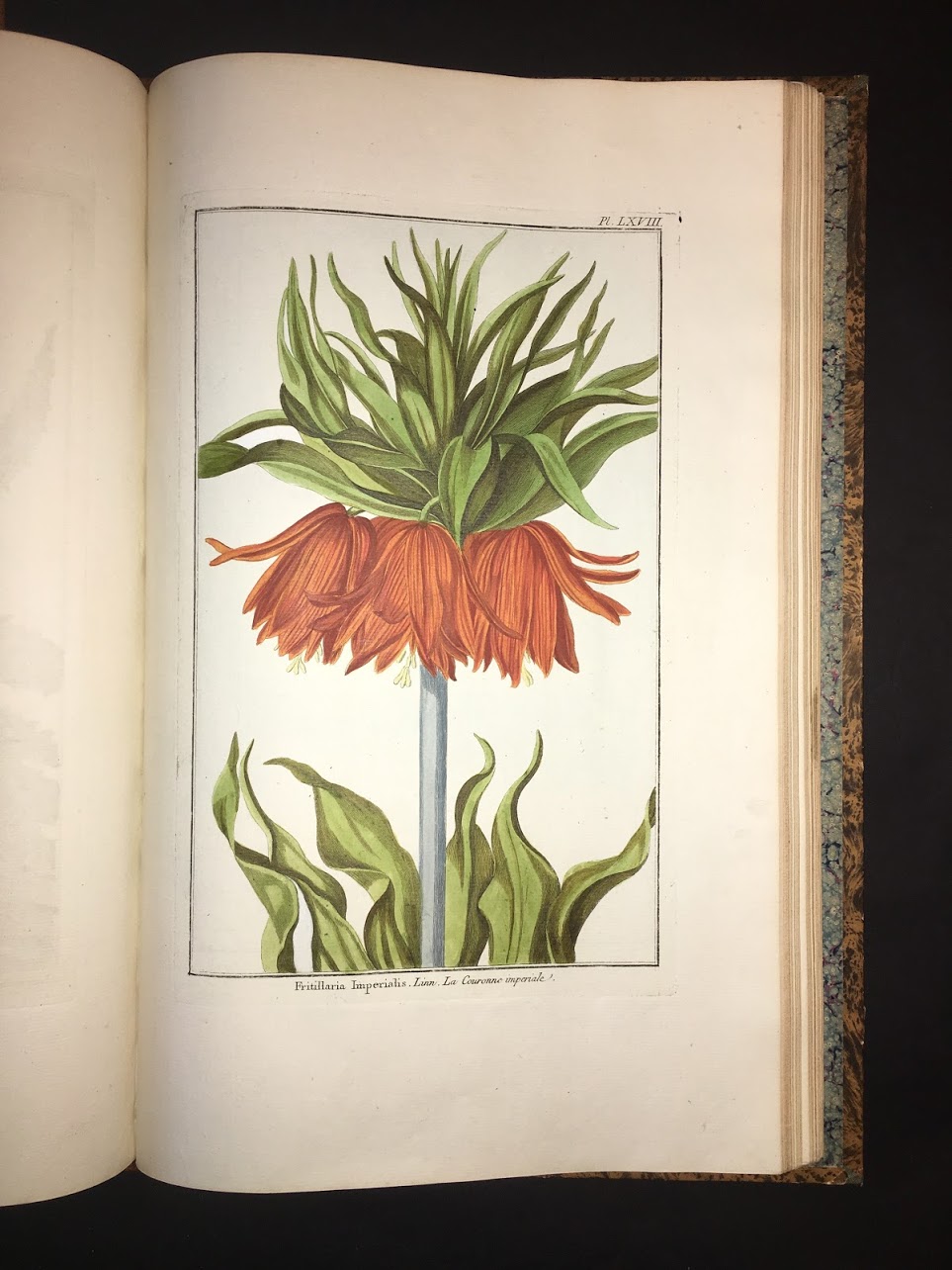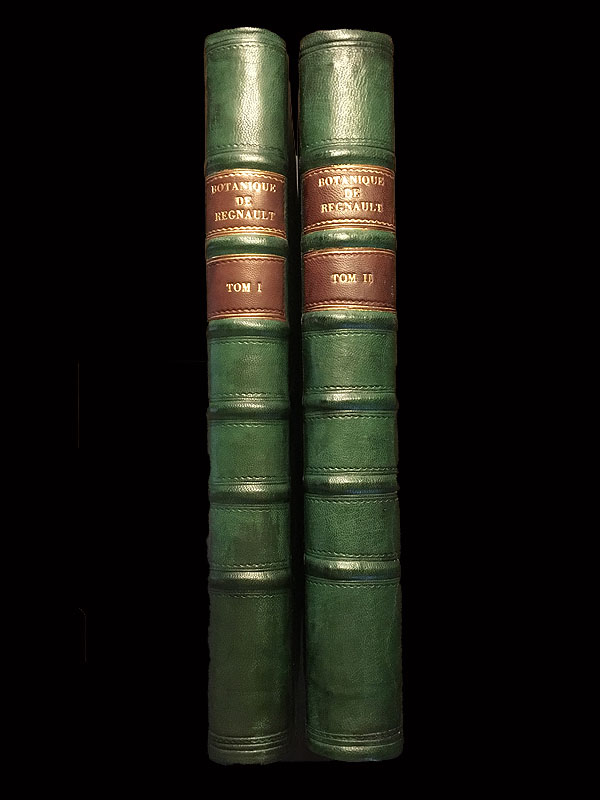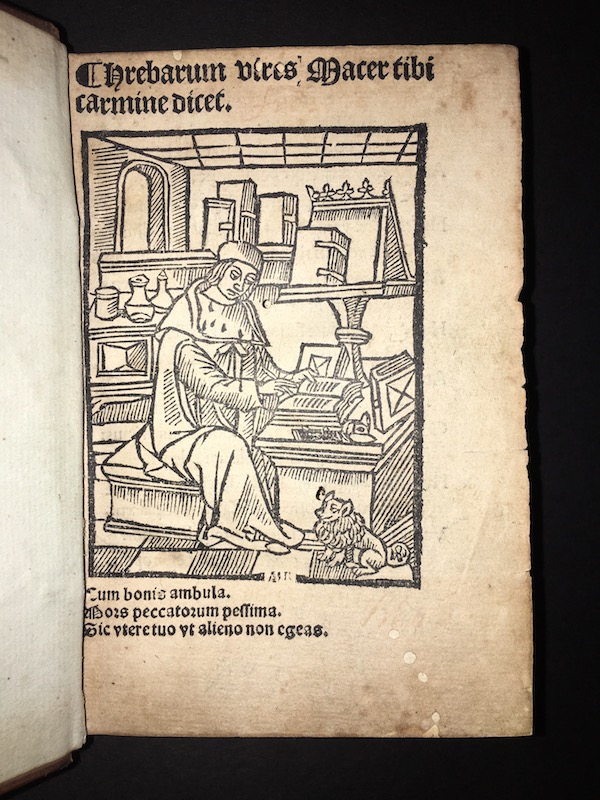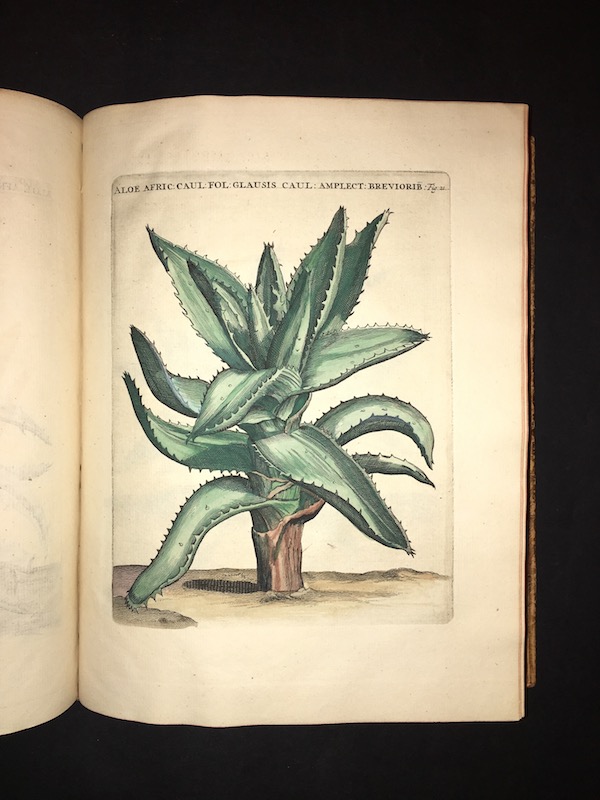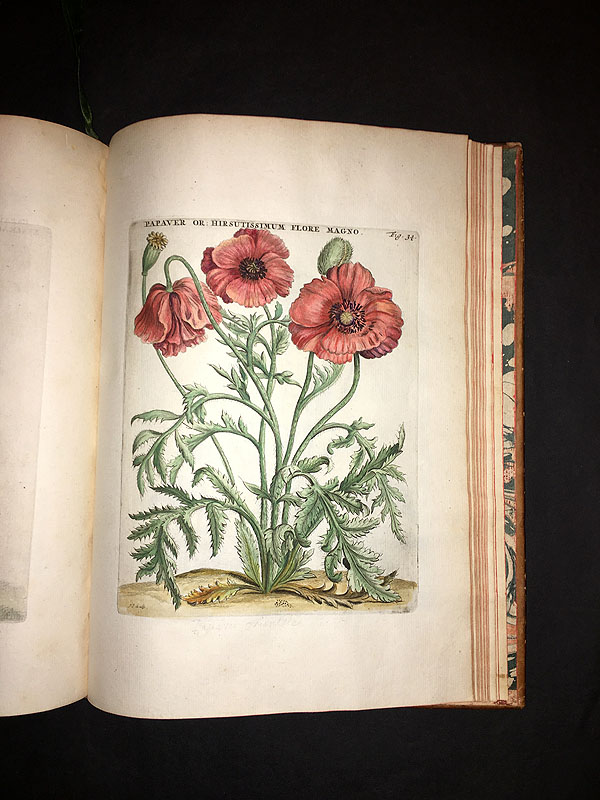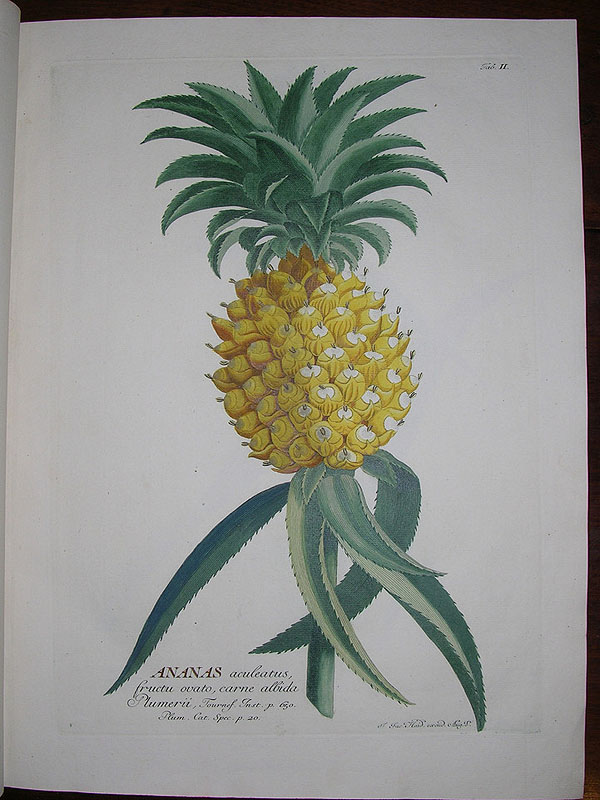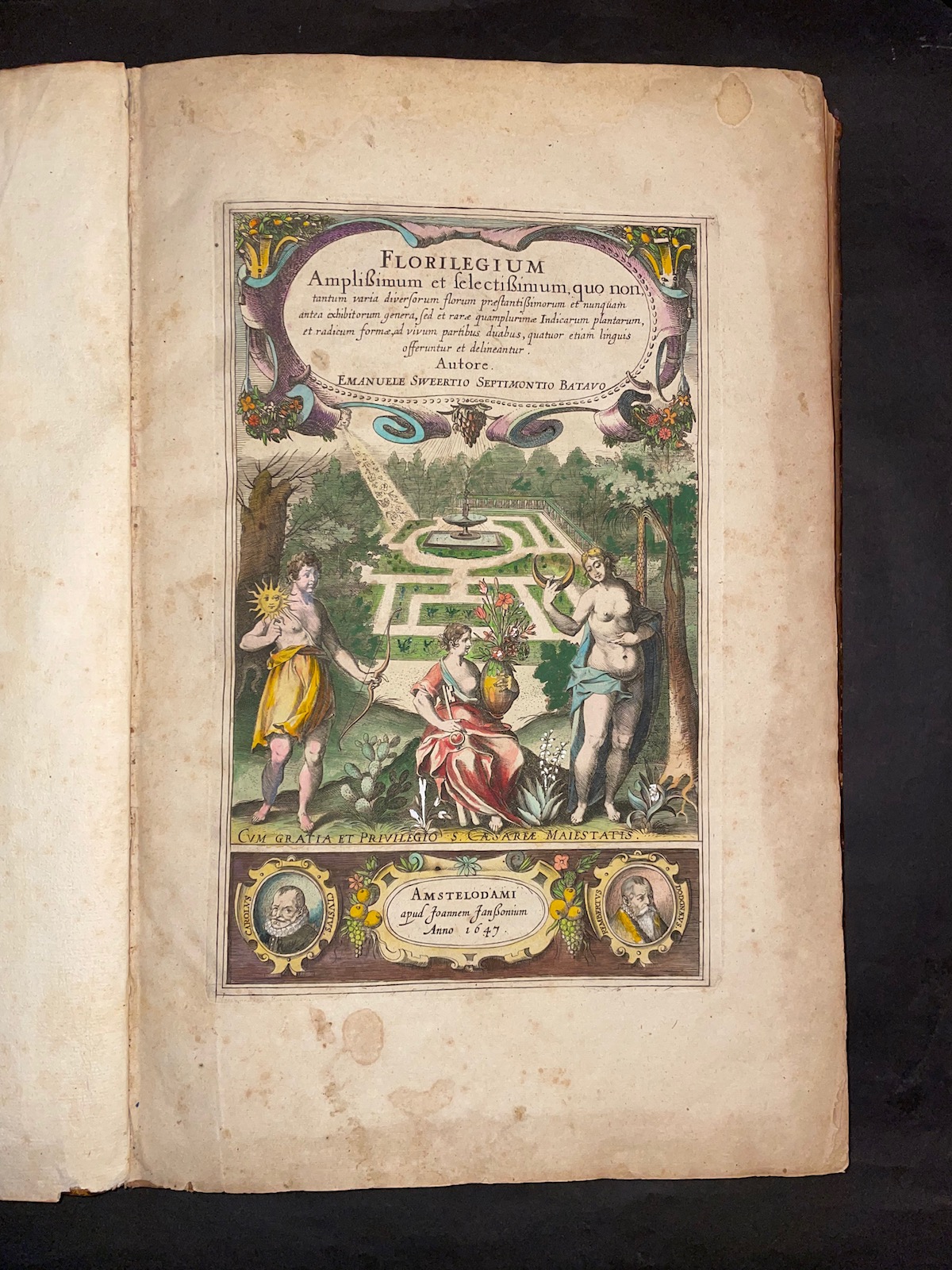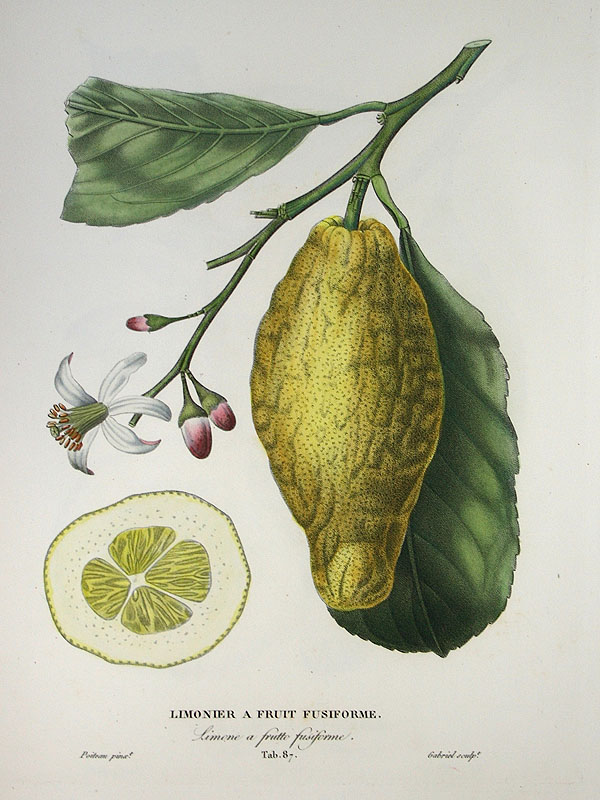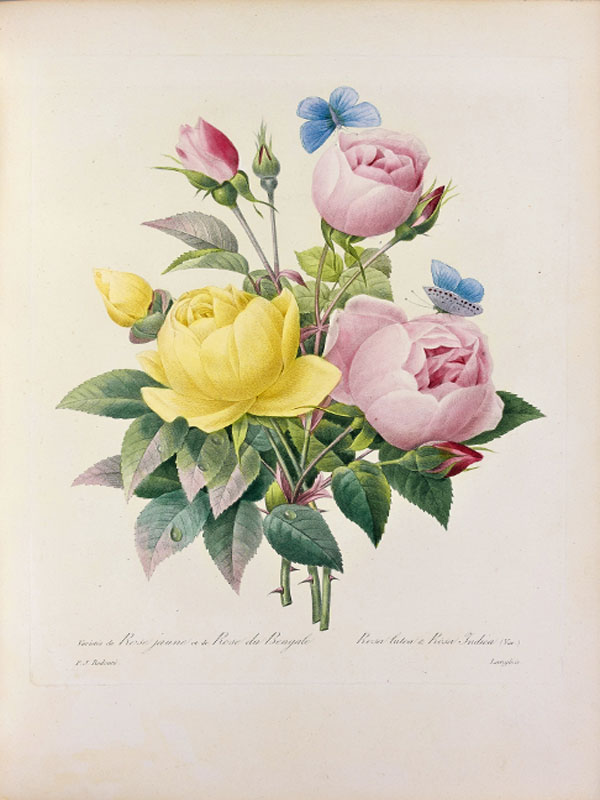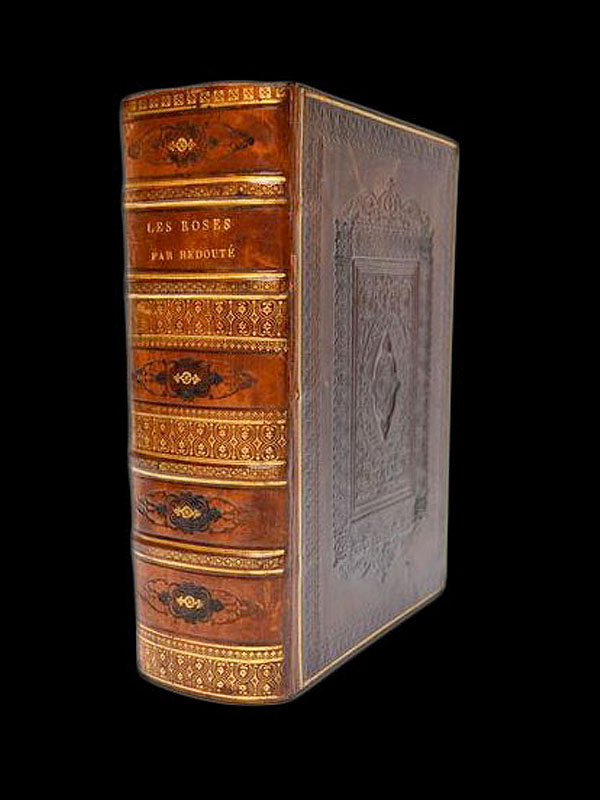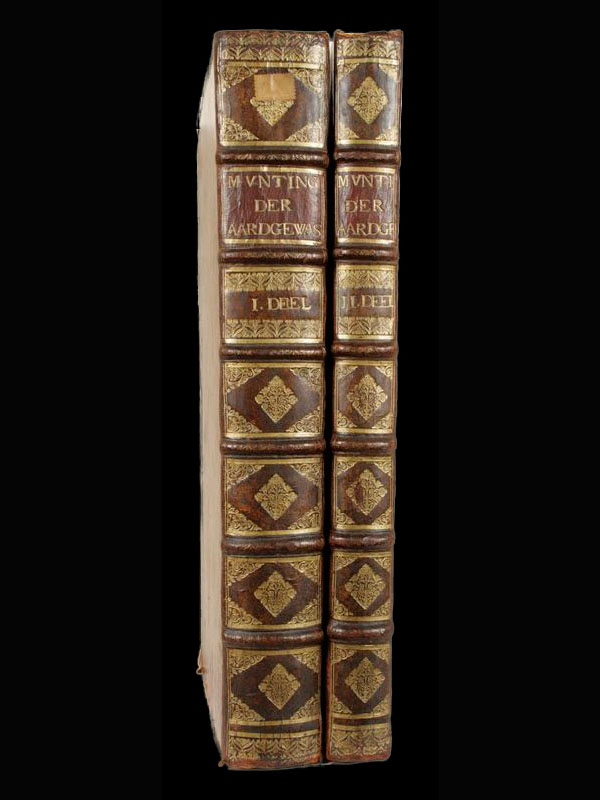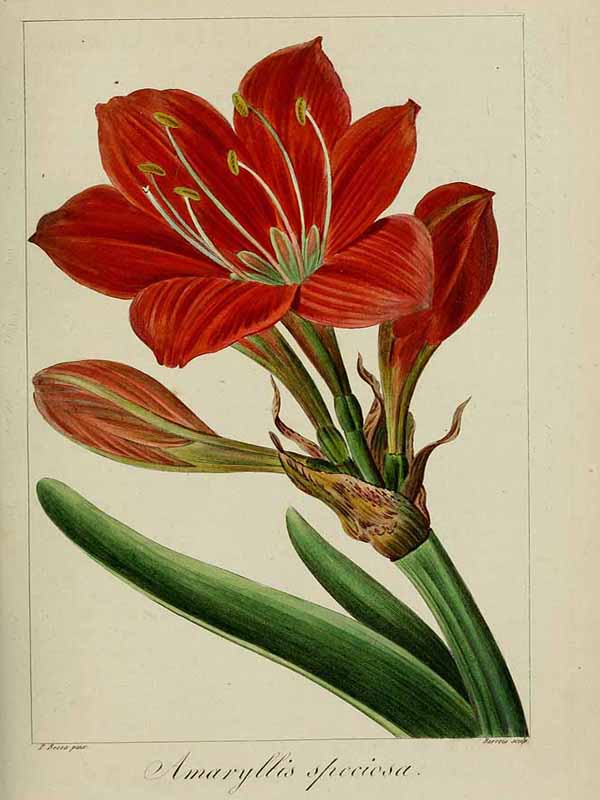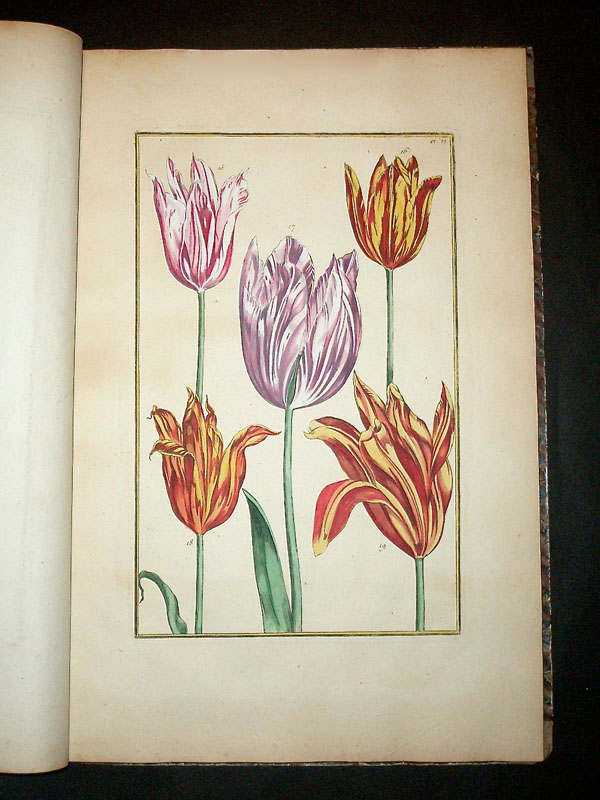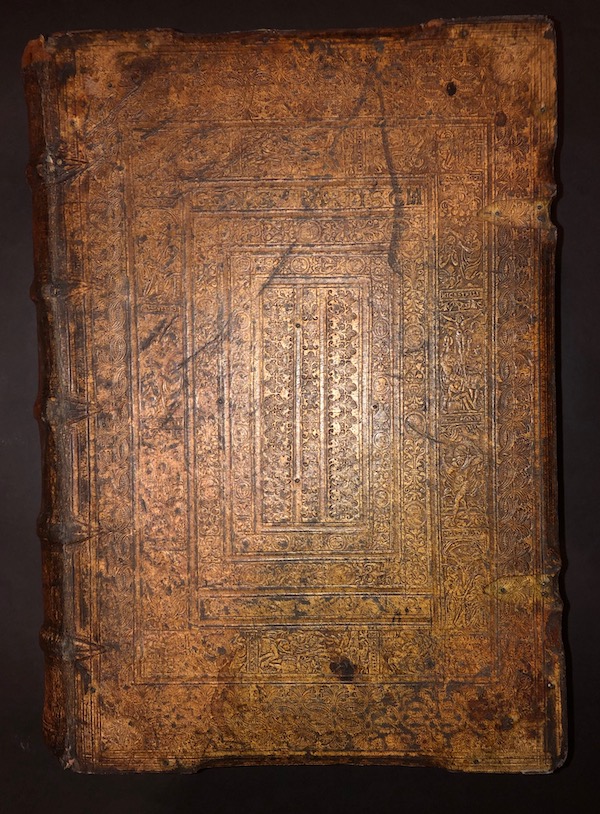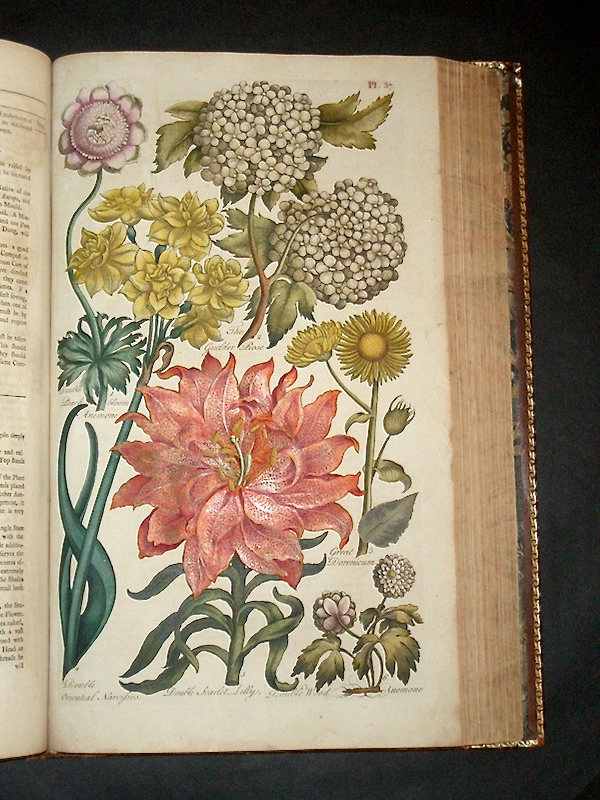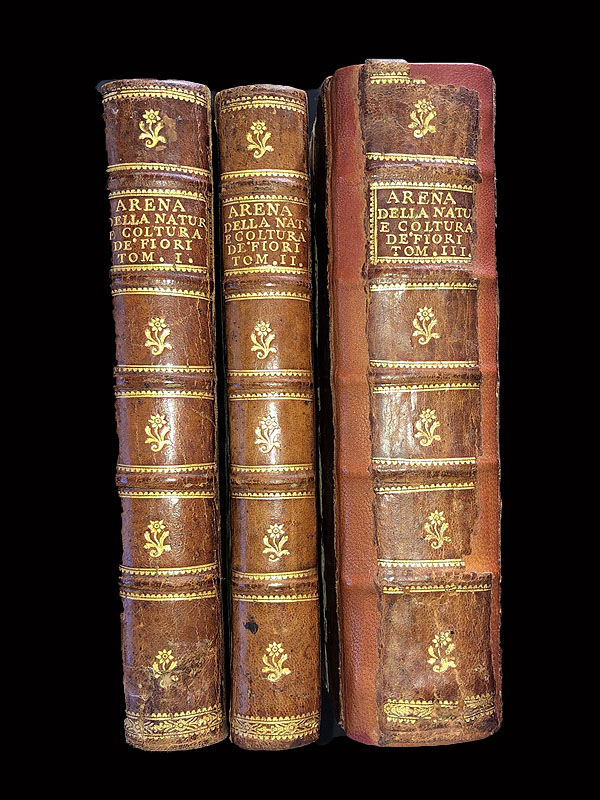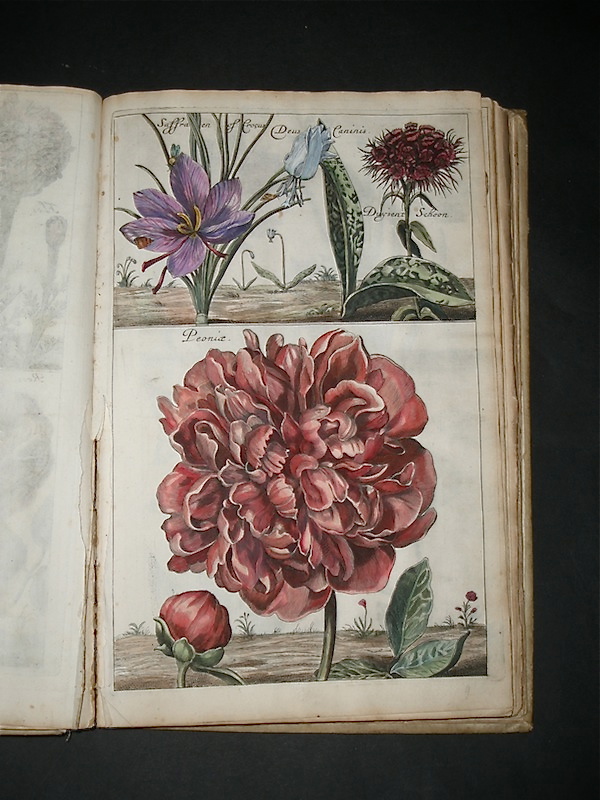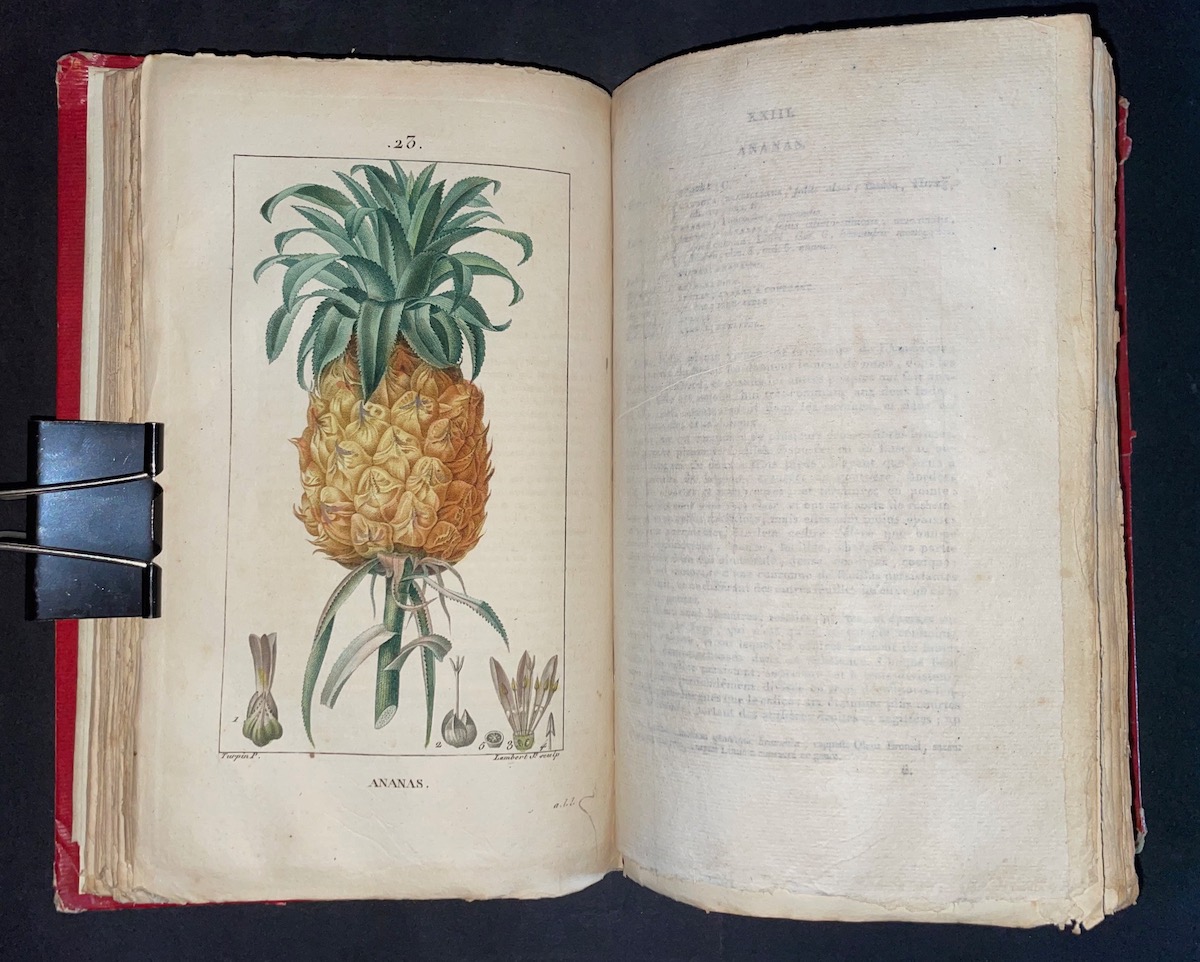
Rare Botany Books - Robert - Flora
Anthology, Paris, 17th Century
Nicolas Robert & Jean Vaquier.
I. Diverses oyseaux dessignées et gravées d' apres le naturel par N. Robert.
A Paris F. Poilly excudit. (probably after 1673). With 31 engraved plates.
II. Ders. Variae ac multiformes Florum species appressae ad Vivum et aeneis tabulis incisae. Diverses fleurs dessinees et gravees s'apres le naturel.
Paris, F. Poilly, (after 1665). With engraved title. Title and 30 engraved plates by Robert.
III Jean Vauquer, Livres de fleurs.
(Paris: Poilly) (c. 1680). With 10 engraved plates (incl. title) by Jean Vauquer and 48 engraved flower bouquets.
Folio. Central binding with red ribbed label and gilt embossing (somewhat rubbed).
Manuscript ex-libris: "Vient de la bibliotheque de Mr. de la haye fermier general" (i.e. Martin de la Haye, 1684-1753).
I. No copy traceable in the international trade. cf. Bradley Martin 1837. - Nissen, IVB 787 - Ronsil 2599. Impressive and rare set of large-format bird engravings by Nicolas Robert (1614-85), who worked as "Peintre du Roi" for Louis XIV since 1644 and drew his inspiration often from the Versailles Ménagerie. The splendid panels, mostly with several birds of each species in a fully executed landscape, inscribed in the plate with their Latin and French names, including eagle, vulture, owl, swan, wild goose, gulls, crane, heron, stork, ostrich, chickens, turkey, parrots and pigeons.
II. Third edition of the well-known "Florilegium", which was first published in Rome in 1640 and contained anemones, lilies, daf- anemones, lilies, dafodils, roses, tulips, etc., each with the Latin names of the flowers and Robert's monogram. This edition of the book, which was published by François de Poilly (1623-93) in Paris after 1669, is the most widely used edition. The album was previously copied by Robert. These copies show the popularity of his compositions and contributed to their dissemination. Maria Sybilla Merian used the plates as illustrations for her History of Insects in Europe (Amsterdam, 1730).
III. No copy traceable in the international trade. Dunthorne 317 - Ornamental engraving cat. Bln. 4432, 4. - Slightly browned throughout, rarely somewhat stained, restored tear on one plate, small marginal tear on another plate. Overall a good copy of this rare anthology.
Rarely somewhat stained, restored tear on one plate, small marginal tear to another plate. Overall a good copy of this very rare anthology.

Rare Botany Books - Bonelli - Hortus romanus
Hortus romanus, Romae, 1772-1780
BONELLI (Giorgio)
Hortus romanus juxta systema tournefortianum paulo strictius distributus a Georgio Bonelli...
Romae, Sumpt. Bouchard and Gravier, ex typographia Pauli Junchi, 1772-1780.
6 large folio volumes, recent half-chagrin garnet binding with corners, spine with 7 raised bands, gilded title and volume number, watermarks on the text and some pl. in vol.2, in the margin at the beginning of vol.3, more sustained and extensive in vol.4, sporadic staining and staining).
Rare first edition of one of the most beautiful botanical books ever published in Italy.
Nissen points out from the book's prospectus that only 300 copies were produced, and of these, a very small number were colored. These 6 volumes offer 600 plates of engraved and colored plants and flowers. Without volumes 7 and 8 published respectively in 1784 and 1793, which are missing from most collections. Each title page printed in red and black is illustrated with a colored vignette.
Copy with large margins (h = 54.5 cm. excluding binding). Bonelli, a physician and professor of medicine in Rome, contributed only a short text following Tournefort's principles of plant identification in Vol. I, the following volumes were composed by N. Martinelli (professor of botany in Rome), according to the Linnaean binomial system, from texts and specimens provided by Liberato and Constantino Sabbati. T.I. Horti romani brevis historia... Classis prima: de herbis et suffructibus flore monopetalo campaniformi. Classis secunda: de herbis et suffructibus flore monopetalo infundibuliformi et rotato, sectio I. - 1772. [4] f., VIII-30 p., 1 plan of Rome engraved on copper, 100 plates. T.II. Classis secunda, sectio II-VIII. - Classis tertia; de herbis et suffructibus flore monopetalo anomalo, sectio I-IV. - 1774. [2] f., VI-22 p., 100 plates. T.III. Classis IIIa, section IV-V. - IVa: de herbis et suffructibus flore monopetalo labiato, sectio IV. - 1775. [2] f., IV-18 p.; 100 plates. T.IV. Classis Va: de herbis et suffructibus flore polypetalo cruciformi. Classis VIa: de herbis et suffructibus flore rosaceo, sectio I-IV. - 1776. [3] f., IV-18 p.; 100 plates. T.V. Classis VIa, section V-IX. Classis VIIa: de herbis et suffructibus flore polypetalo rosaceo umbellato, sectio IV. - 1778.[3] f., 20 p.; 100 plates. T.VI. Classis VIIa, section VI-VIII. Classis VIIIa, de herbis et suffructibus flora polypetalo charyophyllaeo. Classis IXa, de herbis et suffructibus flore liliaceo. - 1780. [3] f., 18 p.; 100 plates. (Nissen BBI 200; Pritzel 976)
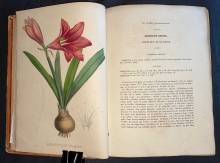
Rare Botany Books - Van Geel - Flore de l'Amateur
Flore de l'Amateur, Paris, Leroi, 1847.
Van Geel, Pierre Corneille.
Flore de l’Amateur. Choix des plantes les plus remarquables pour leur élégance et leur utilité.
Paris, Leroi, 1847. Folio (354 x 251 mm.). 2 Volumes. With 171 hand-colored plates. Contemporary roan-back orange boards. Some minor moisture staining to margins of plates near the end of volume one, corner of 1 text leaf torn away, endpapers and preliminary pages creased.
Scarce Paris issue of this collection, containing a selection of 171 fine hand-coloured plates after G. Severeyns taken from Van Geel’s Sertum Botanicum (Brussels, 1828-1832).
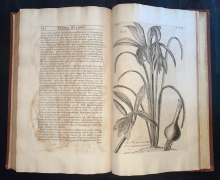
Rare Botany Books - Dillenius - Hortus Elthamensis
Hortus Elthamensis, London, 1732.
Dillenius, Johanne Jacobo.
Hortus Elthamensis seu Plantarum Rariorum quas in horto suo Elthami in Cantio coluit... Jacobus Sherard... delineationes et descriptiones quarum historia vel plane non, vel imperfecte a rei herbariae scriptoribus tradita fuit. (I)-II.
Londini, sumptibus auctoris, 1732. Folio (465 x 278 mm.). (4), V-VIII, 1-206; (2), 207-437, (1) pp. 325 engraved plates by Dillenius (all, some light spotting and offsetting, half titles harder). The first edition, printed in London 1732 is extremely rare, only 145 copies of the plates and 500 of the original text were printed. Late 19th century brown half morocco, somewhat worn, spine with red morocco lettering pieces, raised bands in eight compartments, red speckled edges. Engraved bookplate of Fitzwilliam, red morocco bookplate of Arpad Plesch. 2 volumes. Ref. Sitwell: Great Flower Books (1990) p.91; Hunt 647 (1774 edition); Nissen BBI 492; Stafleu: TL-2 471; Pritzel 2285* THE FITZWILLIAM PLESCH COPY. This was the most important work of its time to record the flora of a private garden. This "magnificent" work (Hunt) depicts the botanical exotica in the Eltham gardens owned by the botanist and apothecary, James Sherard (1666-1738). Dillenius drew and engraved the plates, his skill and accuracy such that they 'were sufficiently accurate to be of considerable service to Linnaeus' (Hunt). Provenance: William Charles, Earl Fitzwilliam (engraved bookplate).
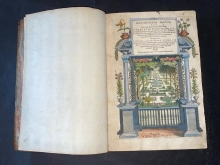
Rare Botany Books - de Bry - Anthologia magna
Anthologia magna, sive Florilegium novum & absolutum, Francofurti, in officina Bryana, 1626
BRY (Johann Theodor de)
Anthologia magna, sive Florilegium novum & absolutum, variorum maximeque rariorum germinum, florum ac plantarum, quas pulchritudo, fragrantia, usus, varietas, differentia commendat…, eicones elegantissimae, summa cum diligentia ad vivum, quantum artifici manu per monochromata fieri potuit, aeri incisae… Francofurti, in officina Bryana, 1626.
In-folio, [6] f. (Etched title depicting formal garden within architectural frame), 141 hand coloured plates, some of which folding, 17th century marbled havana brown calf, somewhat scuffed, gilt 5 rib spine, sides tooled with gilt design, red edges. Occasional light, marginal damp staining on certain plates.
EXTREMELY RARE SECOND EDITION OF DE BRY'S FINELY-ILLUSTRATED FLORILEGIUM, WITH A FULL COMPLEMENT OF PLATES. The plates that illustrate the Florilegium are taken from a variety of sources, including Pierre Vallet's Le Jardin du Roy (Paris, 1608), Basilius Besler's Hortus Eystettensis (Eichstatt and Nuremberg, 1613) and Crispian van de Pass's Hortus floridus (Utrecht and Arnheim, 1614-1616)). However, de Bry's plates are not just copies, as Oak Spring Flora comments: 'The unsurpassed mastery for which de Bry was known throughout Europe emerges clearly in the plates of this florilegium. Each has been carefully composed, and the confident lines of the engraving, with their fine shading, denote the hand of a true master'.

Rare Botany Books - Curtis W. - The Botanical Magazine
The Botanical Magazine, London, S. Couchman, 1793-1817.
William Curtis
The Botanical Magazine; or, Flower-Garden displayed: in which the most ornamental foreign plants, cultivated in the open ground, the green-house, and the stove, are accurately represented in their natural colours.
London, S. Couchman, 1793-1817. Complete First Series (Volumes 1-42 and the "General Indexes" from 1816 - 42/1). Included in the collection are also the first two volumes of the second series - Volumes 43-44.
45 volumes. 8vo (235 x 140mm). With 1934 fine hand-coloured engraved plates. Contemporary uniform red half morocco, richly decorated spines, marbled sides. Together well-preserved copy, untrimmed and wide-margined. An attractive uniformly bound set of the early years of this famous and beautifully illustrated magazine. The magazine has continued publication almost without interruption to the present day and has become a national institute of which Englishmen may justly be proud. It should be noted that the colouring of the earlier volumes, as offered above, is far superior to the later ones.
"It is, indeed, the oldest current scientific periodical of its kind with coloured illustrations in the world, and in the beauty of production and high standard of its contributions it can claim a unique place" (Henry II, p. 302).
William Curtis (1746-1799) was a famous English botanist and is best known for his splendid 'Flora Londinensis' and 'The Botanical magazine'. The noted natural history illustrators, James Sowerby and Sydenham Edwards both found a start with the eminent magazine. The genus Curtisia is named in his honour.Stafleu & Cowan 1290; Nissen BBI, 2350. Buchnummer des Verkäufers 8571.

Rare Botany Books - Knorr - Thesaurus rei herbariae
Thesaurus rei herbariae, Nürnberg, G. W. Knorr,1750-72
Georg Wolfgang Knorr
Thesaurus Rei Herbariae
Knorr´s splendid botanical work, "without doubt the most lovely one of the German flower books. (Claus Nissen).
Nürnberg, G. W. Knorr [1750-72]. Three volumes. Text volume + two plate volumes. Contemporary half-parchment. 39.5: 28 cm. With colored engraved title and 300 hand-colored copperplates. A fresh clean copy with only occasional minor spotting and thumb-soiling.
The very fine plates were all drawn and engraved by Knorr, who also conceived the idea of the work. The first edition was published between 1750 and 1772 and Knorr (who died in 1761) did not live to see it completed. The text was prepared by Philipp Friedrich Gmelin and Georg Rudolf Bohmer.
There is some confusion about the correct number of plates. The present copy is complete with 300 plates, but this includes plate 128 in vol. I, which displays two specimens of roses numbered (according to the original numbering system) R8 and R9. This "double" plate led to the assertion that 301 plates was the correct number. The titles on the plates are in Latin and German. The Latin titles employ a mixture of Linnaean and pre-Linnaean descriptive nomenclature (following Tournefort and others). The accompanying text in Latin and German includes each plant's name, its synonyms, its natural history, and ends (where appropriate) with notes about its usefulness to medicine.
Nissen 1081. - Hunt 538. - De Belder 194. - Coll. A. Plesch 421. - Sitwell/Blunt S. 108. - Pritzel 4757.

Rare Botany Books - Prevost - Collection Fleurs et Fruits
Collection des Fleurs et des Fruits, Chez Vilquin, 1805
Prevost Jean Louis (1760-1810)
Collection des Fleurs et des Fruits.
Paris: Chez Vilquin, 1805. Folio (21 x 14 inches). 48 stipple-engraved plates printed in color and finished by hand, by Louis Charles Ruotte (one by Chapponnier) after drawings by Prevost of flowers and fruit. Contemporary Havana sheepskin. First edition, bound from the original parts. One of the earliest examples of stipple-engraving used to create a grainy effect with a series of dots or flecks using a finely-toothed "roulette" or wheel. Jean Louis Prevost was a successful and widely renowned flower painter, respected both for his watercolor and oil paintings and for his engraved works. His paintings were consistently exhibited in the Paris Salon, and his original watercolors served as models for a series of exquisite color plate botanical books. "A work of outstanding importance and interest ... issued for the specific purpose of maintaining the great French tradition for excellence of design and draughtsmanship. Perhaps no other prints are more worthy of carrying on the tradition of Jean Baptiste and van Spaendonck than these fine examples of Prévost. Whether bouquets or sprays of flowers or fruit, they possess a splendour and freshness amounting almost to fragrance, which is largely due to the quality of the colour printing" (Gordon Dunthorne, Flower and Fruit Prints of the 18th and early 19th centuries, p. 33).

Rare Botany Books - Buchoz - Les dons merveilleux
Les dons merveilleux, Paris, Chez l'auteur, 1779-1783
Buchoz (Pierre-Joseph)
Les dons merveilleux et diversement coloriés de la nature dans le règne végétal, ou Collection de plantes précieusement coloriés, pour servir à l'intelligence de l'Histoire générale et economique des trois règnes, et formant suite à la collection des fleurs curieuses et enluminées qu'on cultive tant dans les jardins de la Chine, que dans ceux de l'Europe.
Paris, chez l'auteur, (1779-1783). 2 volumes. Folio. With 2 engraved title pages, 2 pages engraved index and 200 finely hand-colored engraved plates. Half calf (end of 19th or beginning 20th century), gilt ornamented spines in 7 compartments.
A very rare supplement to Buchoz 's splendid work "Collection de Fleurs de la Chine & de l'Europe'. Hunt (656) comments as follows on the present work: "This is one of the more important works of the copious Pierre Joseph Buc'hoz". Pierre Joseph Buchoz (1731-1807) was a French physician and naturalist. He produced some of the finest illustrated natural history works of the period. 'In some of these works, considerable use is made for the first time of drawings of Chinese plants executed by native artists and much of Buc'hoz's other works also have a distinctly oriental flavour" (Blunt & Stearn p. 179). The coloring of the plates is exquisite. The index gives descriptions of plates 1 to 200. A fine copy without any foxing. Nissen BBI, 283; Hunt 656; Great Flower Books p. 52.

Rare Botany Books - Regnault Nicolas - La Botanique
La Botanique, Paris, the author and Didot le jeune, [1770]-1774-[1780]
Regnault Nicolas François (1746-c.1810) and Geneviève de Nangis Regnault (b.1746).
La Botanique mise a la portée de tout le Monde ou collection des Plantes d'usage dans la Medecine, dans les Alimens et dans les Arts.
Published in Paris: the author and Didot le jeune, [1770]-1774-[1780]. 2 volumes, large folio (500 x 380mm). 472 hand-coloured engraved plates by or after the Regnaults (i.e. 3 plates of botanical details numbered I-III, 469 unnumbered plates. Bound in uniform green sheepskin, spine in seven compartments with raised bands.
First edition of one of the great flower books, illustrated with 472 hand-coloured engraved plates. Besides listing plants with medicinal uses, the work also covers those to be used in gastronomy or in the arts. 'Perhaps the most impressive French botanical book of the period' (Blunt): it took twelve years to complete. The goal of its authors was to produce a botanical treatise for practical use, hence the inclusion of a ‘Table des Maladies’ explaining how each plant should be used against each disease, be it migraine, insomnia, vertigo, apoplexy, or even drunkenness. The vast majority of the plates were drawn from life and a significant number are printed in brown. All show the subject plant, with a section of root and details of flowers and fruits, and underneath each image an identification by their common names, in as many European languages as possible. The facing single page of text includes an identification of the plant according to the classification systems of Linnaeus, Tournefort and Adanson, a botanical description of the plant followed by its uses, then general comments including historical references. Blunt & Stearn, p.171; Johnston 517; Dunthorne 256; Great Flower Books p.131; Nissen BBI 1600; Pritzel 7475; Pinault Sorensen, Le Livre de botanique, 2008, p.70 ('Mme Regnault pose avec delicatesse les couleurs comme en témoignent les planches consacrées à des fleurs aux fins coloris comme le chèvrefeuille, qui orne aussi la guirlande de la page de titre, ou le laurier-rose'); Stafleu & Cowan 8810; Soultrait 18th century 118.

Rare Botany Books - Macer Floridus - Herbarum vires
Herbarum vires Macer tibi carmine dicet np. [Paris] np. [Pierre Baquelier]. nd. [circa 1515]
MACER, Floridus. [ODO, Magdunensis]
Herbarum vires Macer tibi carmine dicet
np. [Paris] np. [Pierre Baquelier]. nd. [circa 1515]
8vo. 160 unnumbered leaves. a-v8. [last blank]. Gothic letter. Large woodcut on title of scholar in his study, 65 large woodcuts of plants within double ruled border. A good copy, crisp and generally clean, bound in 18th century paneled full calf, spine with raised bands ruled in gilt.
Very rare edition of this early French herbal, one of the earliest illustrated editions, with 65 cuts of plants. The work takes the form of a Latin poem in hexameters, a poetic verse form that was most likely employed as a mnemonic device for physicians and midwives, describing the medical virtues of herbs. It was written under the pseudonym of Macer (with reference to the Roman poet Aemilius Macer, d. 15 BC).
The author is generally identified with the French physician Odo de Meung-sur-Loire whose name is mentioned in a 12th-century copy of the text. This is “Perhaps the second edition with the prose commentary of Guill. Gueroaldus, which probably first appeared at Caen in 1509: see Brunet, III. 1270. The woodcut on the title is adapted from the earlier editions. The 65 woodcuts of plants are closely copied also, but now have double line borders.
The text titled has been traditionally attributed to Odo de Meung, who is believed to have lived during the first half of the 11th century. Recent research has shown, however, that the De Viribus Herbarum was probably written in an earlier version, perhaps during the tenth century in Germany. The text was further expanded, including new data from the translation of Arabic texts into Latin in Salerno from the end of the 11th century onward. If this is the case, this text is good evidence of the continuity of scientific activity in the Middle Ages: its most ancient parts come from a period when there was a revival of interest in botany and a recovery of the classical tradition, while the most recent additions integrate the contribution of the Arabic world.
“What was undoubtedly one of the more widely read works in this field (Botany) during the entire medieval period appeared contemporaneously with both Constantinus and the rise of Salerno. This work, an herbal entitled Macer Floridus De Virtutibus Herbarum, consists of a catalogue of 77 herbs and their supposed medicinal properties; all expressed in 2269 lines of vulgar Latin verse. Even more curious is the fact that the poem not only refers to earlier medieval and botanical authors such as Walafrid Strabo; it was itself copied in part into the most significant remaining document of the medical school of Salerno, the Regimen Sanitatis Salernitanum. Macer Floridus is important not only for medical and botanical knowledge but also for a wider range of medieval intellectual history. Its significance lies in the fact that it is the first document of such length to indicate a renewed interest in these subjects in the 11th century, and appears to reflect no direct influence from any Arabic sources.” Bruce Flood. ‘The Medieval Herbal tradition of Macer Floridus.’
One of the earliest editions with the esteemed commentary by Guilelmus Gueroaldus (Gueroust or Gueroult), who was professor of medicine at Caen at the end of the 15th century. There exist different editions of the Macer Floridus consisting of the same number of 159 leaves, with the signatures a-v. Although they resemble each other very much, they are not identical. Becher.
BM STC Fr. C16th p. 295. Fairfax Murray I 347. Renouard, Imprimeurs et libraires parisiens du XVI siecle, t.3 n.35. Becher, A Catalogue of Early Herbals, 65. Arber p. 40.

Rare Botany Books - Commelin - Botanica
Praeludia botanica, Leyden, Joh. du Vivie, 1715
Commelin (Caspar)
Praeludia botanica ad publicas Plantarum Exoticarum demonstrationes dicta in Horto medico, cum demonstrationes exoticarum 3 Octobris 1701, & 29 Maji 1702.
Published in Leyden, Joh. du Vivie, 1715. 4to. pp. (viii), 85, (1), with 33 hand coloured engraved plates. Full calf. A reissue of this title, which first appeared in 1703. "The 'Praeludia botanica' is an important work because it offers the first illustrations of certain aloes and other plants" (Hunt p. 405). Wijnands (1973) provides an example of the importance of the book for the typification of South African taxa" (Stafleu & Cowan). Include in the volume are the two leaves describing the "Aloe Americana Polygona", which are sometimes absent. The first engraving in the book, and arguably the most important plant recorded here is the "Geranium africanum", the ancestor of most modern geraniums introduced to Europe in 1700.
Caspar Commelin (1667/68- 1731) was professor of botany and director of the botanical garden of Amsterdam at a time that numerous South African plants were introduced through the Dutch East Indies Company and first grown in the Amsterdam 'Hortus Medicus'. He succeeded his uncle Jan Commelin.Stafleu & Cowan 1185; Nissen BBI, 388; Kerkham, Southern African Botanical Literature, 159. Buchnummer des Verkäufers 9466

Rare Botany Books - Commelin C. - Horti medici
Horti medici Amstelaedamensis, Leyden, F. Haringh, 1706
Commelin (Caspar)
Horti medici Amstelaedamensis plantae rariores et exoticae.
Published in Leyden, F. Haringh, 1706. 4to. pp. (8), 48, with 48 beautifully hand colored engraved plates. Contemporary full calf, richly gilt ornamented spine. First edition. Intended as a supplement to his uncle's 'Horti medici Amstelodamensis' 1697-1701. A second edition appeared 1715. Many South African plants are described such as succulents and aloes. "The rapid expansion of the collection of the Hortus Medicus soon made it one of the richest collections of exotic plants in Europe. In many cases, the Commelins published the first illustration of a species. From 1686 onward, water-colours were made of exotic plants in the Hortus, resulting in the first eight volumes of the Moninckx Atlas. This collection served as the main source for the illustrations of the four volumes published by Jan and Caspar Commelin (in 1697, 1701, 1703, 1706 respectively' (Wijnands). From the 48 engraved plates by Pieter Sluyter 41 were taken from the 'Moninckx Atlas'. Bibliotheek van de Amsterdamse Hortus 7.5; Stafleu & Cowan 1186; Gun & Codd, Botanical Exploration of Southern Africa p. 5; Kerkham, Southern African Botanical Literature, 158. Buchnummer des Verkäufers 9465

Rare Botany Books - Trew C.J. & Ehret G. - Plantae Selectae
Plantae Selectae, Nuremberg, 1750-1753
TREW, Christoph Jakob - EHRET, Georg
Plantae selectae quarum imagines ad exemplaria naturalia Londini, in hortis curiosorum nutritamanu artificiosa doctaque pinxit Georgius Dionysius Ehret. Nuremberg, 1750-1773.
Two volumes. Folio (20 x 13 5/8 inches). Fine engraved general title-page HEIGHTENED IN RED AND GOLD (issue without the sectional title-pages), 3 mezzotint portraits of Trew, G.D. Ehret, and J. J. Haid, 100 MAGNIFICENT hand-colored engraved plates after Georg Dionysius Ehret by Johann Jakob Haid, each with the first word of the caption HEIGHTENED IN GOLD. Contemporary calf, decorated with geometric ornaments. First edition, and the magnum opus of the long and fruitful collaboration between Trew and Georges Ehret, and Trew. Ehret traveled widely, sending back hundreds of botanical drawings and paintings, which were included in the present work. For "Plantae Selectae", the level of botanical interest and exotic appeal were how the two chose which illustrations to use. They had to decide on a way to present these tropical subjects to the public that had only recently been introduced to Europe. Johannes Jacobus and Johannes Elias Haid translated Ehret's exceptional and remarkably sensuous watercolors into hand-colored engravings that represented everything Ehret's work was about. Ehret had met Linnaeus in 1736 and the latter's work moved the artist to analyze the structure of the plant before trying to represent it. The Latin text was written by Trew and describes each plant, the history of its discovery and additional comments. Each species is compared with descriptions written by other botanical authors in order to definitively classify each plant. This great work was not finished until after Ehret's death, though his instructions were followed as to the layout. Linnaeus praised this work in a letter to Trew, calling it one of the great miracles of the century.
THE MAJORITY OF THE PLATES IN EHRET'S MAGNUM OPUS ARE EXOTIC SPECIES NATIVE TO THE AMERICAS:
Plate II. Ananas aculeatus, or the Hawaiian Pineapple
Plate III. Ananas folio vix ferato, or the Red Pineapple, native to Brazil
Plate IV. Bocconia racemosa , or Tree Celandine, native to Jamaica
Plate V. Anona fructu lutescente, a relative of the Custard Apple, native to the West Indies, Central America and Mexico
Plate VI. Araliastrum foliis ternis quinquepartitus, or Ginseng, native to Asia and to Canada
Plate VII. Papaya, native to Central America and Mexico
Plate VIII, LVII. Species of Corallodendron, or Flame Tree, or American Coral Tree, found throughout the tropics
Plate IX. Magnolia Lauri folio, or Sweet-flowering Bay, native to the Atlantic Coast of America
Plate X. Liriodendrum, or Tulip Tree, native to Eastern America
Plate XI. Lilium foliis Sparsis, or Tiger Lily, native to Western America
Plate XII. Meadia, or Eastern Shooting Star, native to the Eastern and Central United States
Plates XIV, XXX, XXXI, XXII, all species of Cereus, or cactus, native to the Western United States, Mexico and South America
Plate XV. Pavia, or Scarlet Buckeye, native from North Carolina south to Florida, west to central Texas, and as far north as Illinois
Plate XVII. Mespilus, or May Hawthorne, native from South Carolina, south to northern Florida, west through the Gulf states to southern Arkansas and the valley of the Sabine river, Texas
Plates XVIII, XIX, XX, XXI, XXII, XXIII, all species of Banana, while technically an import, found throughout the West Indies at the time this book was published
Plates XXIV, LXVIII. Species of Lycium, a member of the Nightshade family, found throughout America
Plate XXIX. Podophyllum, or Mayapple, widespread across most of the eastern United States and southeastern Canada
Plate XXXIII. Magnolia maximo flore, or Magnolia Grandiflora, native to the southeastern United States, from Virginia south to central Florida, and west to East Texas and Oklahoma
Plates XXIV, XXIV. Hura, or Sandbox Tree, native to tropical regions of North and South America, including the Amazon Rainforest
Plate XXXVI. Acacia non spinosa, or Prairie Wattle, native to southern parts of North America, the Caribbean and the majority of South America
Plate XXXVII. Yucca, native to the hot and dry (ie arid) parts of North America, Central America, South America, and the Caribbean
Plate XXXVIII. Ledum, or Mountain Laurel, native to north-eastern North America, southern Maine south to northern Florida, and west to Indiana and Louisiana
Plate XLI. Plumeria, or Frangipani, native to Central America, Mexico, the Caribbean, and South America as far south as Brazil
Plate XLIII. Guiaba, or Guava, native to Mexico, Central America, and northern South America
Plate XLV. Heliocarpus, sometimes called Majaguillo, native to Central America
Plate XLVI. Tacamahaca, or Balsam Poplar, or Balm-of Gilead, native to most of the Northern United States and Canada
Plate XLVIII. Azalea scapo nudo, or Sweet Azalea, first described by John Bartram in 1814, native to the eastern United States
Plate XLIX. Guanabanus, or Soursop, native to Mexico, Cuba, Central America, the Caribbean, and northern South America, primarily Colombia, Brazil, Peru, Ecuador, Venezuela, and Puerto Rico
Plate L. Bromelia, native to tropical Americas
Plates LIII, LIV, LV. Species of Indigofera, or Indigo plant, technically and import, but grown widely in the West Indies and Carolinas when this book was published
Plate LIX, LXV. Sophora, or Pea-flower, found in western South America, the western United States, Florida and Puerto Rico
Plate LXII, LXIII. Magnolia, or Umbrella Magnolia, native to the southeastern United States in the Appalachian Mountains region
Plate LXIV. Monarda, or Wild Bergamot, native throughout Canada, the United States and Mexico
Plate LXVI. Rhododendrum, or Carolina Rhododendron, native to eastern North America, particularly Virginia and North Carolina
Plate LXVII. Petivera, or Pokeweed, native to Florida and the Lower Rio Grande Valley of Texas in the United States, Mexico, Central America, the Caribbean, and tropical South America
Plate LXIX, LXX. Laurus, or Sassafras tree, native to northeastern America
Plate LXXVI. Theabroma [sic], or Cacao, native to the tropical forests of Central and South America, and used to make chocolate
Plate LXXVII. Veratrum, or Helonias, or Swamp Pink, a rare perennial rhizomatous herb native to the eastern United States
Plate LXXVIII. Urtica, or Stinging Nettle, native to North America
Plate LXXXI. Melanthium, or Bunch Flower, native to North America
Plate LXXXIII. Pontederia, or Pickerel Weed, found throughout the Americas
Plate LXXXV. Acer, or Sugar-Maple, native to the hardwood forests of northeastern Canada, from Nova Scotia west through Quebec and southern Ontario to south eastern Manitoba around Lake of the Woods. In the USA, the species is common from Minnesota, to the New England states of Maine, Vermont, New Hampshire, Massachusetts, Connecticut, and Rhode Island, and down to the Eastern seaboard states of New York, New Jersey, and Pennsylvania. They are also found as far south as Georgia and Texas
Plate LXXXVI. Acer, possibly the Red Maple, one of the most common and widespread deciduous trees of eastern North America.
Plate LXXXVIII. Chelone, or White Turtlehead, native to eastern North America
Plate LXXXIX. Sida, or 'Ilima, from Hawaii
Plate XC. Abutilon, or Sweet Pelotazo, or Indian mallow, native to the American tropics
Plate XCIV. Ceanothus, of California Lilac, native to North America and found most commonly in California
Plate XCV. Mimosa sensitiva, (although the leaves are depicted incorrectly), native to Central America
Plate XCVIII. Itea Virginica, or Virginia Sweetspire, native to the southern United States from New Jersey to Texas
Plate XCIX. Ellisia Nyctelea, or Aunt Lucy, endemic throughout the United States
Plate C. Iris, or Rainbow Iris, native to California
Like his father before him Ehret trained as a gardener, initially working on estates of German nobility, and painting flowers only occasionally, another skill taught him by his father, who was a good draughtsman. Ehret’s “first major sale of flower paintings came through Dr Christoph Joseph Trew, eminent physician and botanist of Nuremberg, who recognized his exceptional talent and became both patron and lifelong friend. Ehret sent him large batches of watercolours on the fine-quality paper Trew provided. In 1733 Trew taught Ehret the botanical importance of floral sexual organs and advised that he should show them in detail in his paintings. Many Ehret watercolours were engraved in Trew's works, such as ‘Hortus Nitidissimus’ (1750–86) and ‘Plantae selectae' (1750–1773) [as here], in part two of which (1751) Trew named the genus Ehretia after him.

Rare Botany Books - Tilli M. - Plantarum Horti Pisani
Catalogus Plantarum Horti Pisani, Firenze, Tartini & Franchi, 1723
Tilli (Michelangelo)
Catalogus Plantarum Horti Pisani.
Published in Firenze, Stamperia Reale, Giovanni Gaetano Tartini e Santi Franchi, 1723. Folio. First edition. Half title, engraved portrait frontispiece of the author (Cruyffe after Redi), main title printed in red and black with a hand-colored engraved vignette, 2 folding engraved garden plans, 50 engraved plates by Mogalli after Tilli, colored by hand, contemporary editorial binding. "The Botanical Garden at Pisa was founded around 1543 and was (with that at Padua, 1545) one of the first such gardens in Europe... Thus the long alphabetical list of plants in this volume is one of the most important for the early eighteenth century, and the volume memorializes the garden for all time" (Hunt, 457).
The catalogue, listing more than 4 thousand plants, contains species of plants from all over the world. The volume is often said to describe the plants in the garden founded in 1543 by Luca Ghini, but actually describes the definitive garden, after its second relocation during the years 1591-1596, constructed by the Flemish gardener Jodocus de Goethuysen, who served the Medici family in Florence. A few leaves slightly browned. Michelangelo Tilli was born in Castelfiorentino in 1655. In 1677 he graduated in medicine at the University of Pisa and in 1681 was appointed as naval surgeon by Cosimo III. He embarked on a Tuscan galley for the Balearic Islands and went to Constantinople in 1683. From there he spent some time in Albania, and then he went on to Tunis to study the remains of Carthage and to collect botanical specimens. He became professor of botany at Pisa in 1685 and also director of the Botanical Garden of Pisa, introducing plants from Asia and Africa. He was among the first in Italy to use greenhouses for plants, making it possible to cultivate pineapples and coffee in Italy. He became a member of the Royal Society in 1708. Tilli died in Pisa in 1740 (cf. G. Cipriani, Michelangelo Tilli medico, naturalista e diplomatico fra Cosimo III e Giangastone de’ Medici, in: “Il trionfo della ragione: salute e malattia nella Toscana dell'età moderna”, Firenze, 2005, p. 129 e sgg.). Pritzel, 9356; Nissen, BBI, 1967; Olschki, Choix, 2488; Plesch, p. 228 (“La vignette de titre et les 50 planches ont été coloriées à l’époque!”); Catalogo unico, IT\ICCU\PUVE\000543; cf. F. Garbari-L. Tongiorgi Tomasi, Michelangelo Tilli e il Catalogus Plantarum Horti Pisani, in: M. Tilli, “Catalogus plantarum Horti pisani, Ristampa anastatica”, Pisa, 1991, pp. 1-11.

Rare Botany Books - Sweertius - Florilegium
Florilegium amplissimum et selectissimum, Amsterdam, 1631
Sweerts (Emmanuel)
Florilegium amplissimum et selectissimum, quo non, tantum varia diversorum florum praestantissimorum et nunquam antea exhibitorum genera, sed et rarae quamplurimae indicarum plantarum, et radicum formae, ad vivum partibus duabus, quatuor etiam linguis offeruntur et delineantur...
Published in Amsterdam, Johann Jansson, 1631 [bound with:] Florilegii pars secunda... Amsterdam, Johann Jansson, 1631.
Two volumes in one. Folio. pp. [xxviii including frontispiece and portrait]; [x], with engraved frontispiece-title and portrait to part one, and 110 hand coloured engraved plates with 560 figures of plants; a very good copy bound in 17th century brown calf. Occasional light, marginal browning on certain plates. A large copy in its original binding, somewhat scuffed. A later edition (first 1612) of one of the most attractive and popular of the early florilegia. The first part of the work is devoted to bulbous plants, and the second to miscellaneous beautiful and sweet-smelling garden plants. The first two editions were essentially catalogues for the selling of plants and bulbs, while the later editions were true florilegia intended for the connoisseur and the scientist.

Rare Botany Books - Risso A. - Histoire des Orangers
Histoire et culture des Orangers, Paris, Plon, 1872
Risso (Antoine) & Poiteau (Antoine)
Histoire et culture des orangers.
Published in Paris, Plon, 1872. One volume. With 110 stipple-engraved plates, finished with hand coloring after Poiteau by V. Bonnefoi, Chailly, Dien, Gabriel, Legrand, T. Susmihl and Texier. (Some spotting to text and marginally to plates). Contemporary red cloth, spines gilt.
Second edition of this beautiful and inspiring work" (Great Flower Books). Antoine Risso, a French naturalist and pharmacist who became director of the Jardin de Naturalisation in Nice, was a "pioneer botanist of the Alpes Maritimes" (Stafleu). In his dedication to the Duchesse de Berry, he recalls her Italian childhood: "Votre Altesse Royale, en retraant ses yeux l'image des fruits qu'elle cueillit souvent de sa propre main sous le beau ciel de l'Italie". The Redoutesque plates are all from the drawings of Antoine Poiteau (1766-1854). Early in his career Poiteau taught botany and was employed as a gardener; he then made a plant-collecting expedition to the Caribbean. On his return to Paris in 1800, he concentrated on his work as an illustrator of botanical works. Poiteau is often listed as a co-author as well as illustrator of the present work, as, in addition to providing the drawings, Poiteau also contributed information concerning tropical varieties. The first edition was published in 19 fascicles between July 1818 and August 1820, and is one of the most spectacular productions of Parisian color printing in the early nineteenth century: "These oranges and lemons and their relations, with leaves, flowers, and often cross-sections as well as whole fruits, form one of the most beautiful and complete records of the varieties known in the nineteenth century" (Raphael, An Oak Spring Pomona). Dunthorne 263; Great Flower Books p.73; Nissen BBI 1640; Stafleu & Cowan 9248.

Rare Botany Books - Redoute P.J.- Choix Plus Belles Fleurs
Choix des Plus Belles Fleurs, Paris, Panckoucke, 1824
Redouté, Pierre-Joseph
Choix Des Plus Belles Fleurs et Des Plus Beaux Fruits
Published in Paris, Ernest Panckoucke, 1833. Folio. (12 6/8 x 9 2/8 inches). Letterpress title-page, Introduction, 16-page "Table Alphabetique et Explicative". 144 stipple-engraved plates, printed in colors and finished by hand, by Langlois, Bessin, Chapuy, and Victor, after Redouté.”Among the most beautiful of all fruit prints. Plates of greengages, plums, peaches, ladyfinger grapes, raspberries, strawberries, apples, pears and apricots are portrayed so perfectly in the delicacy of the stipple modelling that an impression of a third dimension is created" (Dunthorne) The "Choix", for this Redoute's last great and extremely popular work, is personal: "Éclairé par l'expérience, encouragé par les souffrages les plus flatteurs des naturalistes et des peintres de mon pays et des contrées les plus éloignées; c'est en me livrant aux travaux botaniques les plus étendus, c'est en étudiant sans cesse la nature dans la constance et dans la variété des formes et de ses couleurs, que je crois être parvenu à réussir sous le triple rapport d'exactitude, de la composition et du coloris, dont la réunion peut seule porter à perfection l'iconogrpahie végétale" - "Enlightened by experience and encouraged by the extremely flattering pleas of naturalists and painters from my own country as well as from most distant realms; it is by devoting myself to extensive botanical study, by examining nature unremittingly, observing both its constancy and variety of shapes and colours, that I believe finally to have succeeded, by the triple means of exactitude, composition and colouring, the union of which only, may bring to perfection the iconography of plants" (Redouté, "Preface"). Pierre-Joseph Redoute (1759-1840), often called "the Raphael of flowers," was born in the Belgian Ardennes - the son, grandson, great-grandson and brother of artists. From the beginning, Redoute's talents were recognized by distinguished men and women who took pleasure in forwarding his career. For the study of botany, his teacher was Heritier de Brutelle, one of the outstanding naturalists of his day. Gerard van Spaendonck, Flower Painter to the King, taught Redoute the technique of painting in watercolor on vellum. But by the master's own account, the pupil's work was finer. The luminosity of stipple engraving is particularly suited to the reproduction of botanical detail. It is essentially a technique of engraving a copper plate with a dense grid of dots which can be modulated to convey delicate gradations of color. Because the ink lies on the paper in minuscule dots, it does not obscure the "light" of the white paper beneath the color. After this complicated printing process was complete, the prints were then finished by hand in watercolor, so as to conform to the models Redoute provided. Redoute had, as pupils or patrons, five queens and empresses of France, from Marie Antoinette to Josephine's successor, the Empress Marie-Louise. Despite many changes of regime in this turbulent epoch, he worked without interruption, eventually contributing to over fifty books on natural history and archaeology. The "Choix des Plus Belles Fleurs" is one of Redoute's last works. The "choice" is personal, the favorite flowers and fruits of a master who had devoted a lifetime to the arc of botanical illustration. There are the spectacular blooms of formal gardening, but also many more modest blooms of wayside flowers. Although small in size, these prints have the peculiar virtue of concentration, by which we can savour the essence of each beautiful flower. Dunthorne 235; Great Flower Books page 129; Nissen BBI 1591; Stafleu & Cowan TL2 8750; cf. Hunt, Redouteana 21.

Rare Botany Books - Redoute P.J. - Les Roses
Les Roses, Paris, Panckoucke, 1824
Redouté (Pierre Joseph)
Les Roses, peintes par P.J.R. Descrites par Cl. Ant.Thory.
Published in Paris, C.F.L. Panckoucke, 1824. One volume, large 8vo, with 160 coloured stipple-engraved plates, with the original tissue guards; an extraordinary copy in an exquisite full calf contemporary binding, adorned with extensive gold tooled designs. First 8vo edition of Redouté's gargantuan masterpiece, lavishly illustrated with stipple-engravings by Bessa, Bessin, Chapuy, Charlin, Coutant, Langlois, Lemaire, Talbot, Teillard and Victor after the original aquarelles by Redouté, popularly nicknamed the 'Raphael of Flowers'. Designer and painter of the Cabinet of Marie-Antoinette, and later drawing-master to Joséphine de Beauharnais, Redouté was the first to use aquarelle in preference to gouache in his work, and was thus able to imitate the colors of nature with an extraordinary and wholly new degree of precision and delicacy. Les Roses was published under the patronage of Empress Joséphine, whose passion for flowers was legendary. In constant contact with the foremost rose-growers of Europe, her rose-gardens at Malmaison contained examples of virtually every known species. Justifiably proud, in 1800, she commissioned Redouté to paint them. Some eighty of the roses pictured in Les Roses were definitely Malmaison-grown. On the strength of this work, and the similar Les Liliacés, Redouté won the title of 'Flower-painter to the Empress'. The roses painted by Redouté are divided into three categories: wild roses (known in antiquity), roses of the middle-ages, and modern roses, created in the present day from species imported from Asia. The first volume contains a brief bibliography of roses. 'Redouté and Thory knew, described and figured almost all the important roses known in their day. Included were many of the key ancestors of our present-day roses. The plates in Les Roses have artistic value, botanical and documentary value, both for species and cultivars still surviving and for those that have disappeared' (Gisèle de la Roche). Published by subscription, subscribers received four engravings on a monthly basis. AA. Sitwell 128. Dunthorne 233.

Rare Botany Books - Munting - Description of Plants
Naauwkeurige Beschryving der Aardgewassen, Leiden and Utrecht, 1696
MUNTING (Abraham)
Naauwkeurige Beschryving der Aardgewassen, Waar in de veelerley Aart en bijzondere Eigenschappen der Boomen, Heesters, Kruyden, Bloemen, Met haare Vrugten, Zaden, Wortelen enBollen, Neevens derzelver waare Voort-Teeling, gelukkige Aanwinning, en heylzaame Genees-Krachten, Na een veel-jarige Oeffening en eigen Ondervinding, In drei onderscheide Boeken, naauwkeuriglijk beschreeven worden; Door den Heer...
Published in Leiden and Utrecht: Pieter Vander Aa and Francois Halma 1696. Two volumes in-folio [340)] + 1-640 col., [2] + 641-930 [i.e. 932] col. + [32] ff. Title printed in red and black, text printed in 2 columns. With engraved title-page, 7 engr. headpieces, 5 engr. tailpieces, 243 numbered engraved plates Contemporary full calf, ribbed spine with gold-tooling.
First edition and a large paper copy printed on heavier paper of this extraordinary florilegium. Abraham Munting (1626-1683) was professor of botany at the University of Groningen and considerably enlarged the botanical garden his father Henricus Munting had founded. It was known as the "Paradise of Groningen" and became one of the most extensive gardens of the period. "Munting wrote a number of works on medical-botanical topics, but his posthumously published 'opus magnum', the 'Naauwkeurige', enjoyed particular success, at least in part due to the novelty of the plates, which in a radical departure from the iconography of the traditional florilegium, presented its plant species against a charming series of landscape backgrounds. The illustrations are remarkable for their elegance and originality. The sophisticated title-page was designed by an artist of considerable merit, Jan Goeree (1670-1731). Each plate shows a different plant in flower, including many exotic species from America and other distant lands. The plant dominates the foreground, filling the entire page, often with a detail of the fruit or flower presented on a smaller scale. In some cases the plants are presented 'à trompe l'oeil', while in others they have been arranged in decorated urns. Sometimes gardening tools are depicted as well. The name of each plant appears written on an elegantly fluttering ribbon or cartouche, or on a crumbling marble plaque" (An Oak Spring Flora, 45). Only plate 201 is signed, bearing the name of Joseph Mulder (1659-1710) who engraved many of the plates of Maria Sibylla Merian's famous work on the insects of Surinam. Nissen BBI, 1429; Pritzel 6559.

Rare Botany Books - De Launay - Herbier de l'amateur
Herbier Géneral de l'amateur, Paris, Audot, 1816-1827
Mordant de Launay, [J. C. M.] and Loiseleur-Deslongchamps, [J. L. A.]
Herbier géneral de l'amateur, contenant la description, l'histoire, les propriétés et la culture des végétaux utiles et agréables.
Published in Paris, (Didot Jeune for) Audot, 1816-27. 8vo. Eight volumes. With 576 colored copper plates (6 double page) after P. Bessa. Contemporary leather-backed paper covered boards, leather corners, edges untrimmed.
First edition of the splendidly illustrated work on plants, dedicated to the French king. The fine hand-colored coppers were mostly engraved after drawings by the Redouté pupil, Pancrace Bessa, also one copper after Redouté self and one after A. Poiteau. Participating engravers were Barrois, Bigan, Brion de la Tour, Callens, Coignet, Susémihl et al.
Pancrace Bessa (1772 – after 1834) was a French natural history artist, best known for his botanical illustrations. Bessa was a student of the great engraver Gerard Van Spaendonck and worked alongside Pierre-Joseph Redouté, some of whose influence shows in Bessa's detailed and delicate treatment of his subjects. He was a regular exhibitor at the Paris Salons between 1806 and 1831.
Bessa's favorite subjects were fruit and flowers, with occasional digressions to birds and mammals. In 1816, the Duchesse de Berry daughter-in-law of King Charles X of France extended her patronage to him, which led to his giving painting lessons to the de Berry family. Nissen 2323. - Sitwell/Blunt p. 159. - De Belder 246. - Plesch Rép. p. 256.

Rare Botany Books - Merian M.S. - Insectes de Surinam
Histoire générale des insectes de Surinam et de toute l'Europe, Paris, Desnos, 1771
Merian (Maria Sybilla). Attributed to Daniel Rabel.
Histoire générale des insectes de Surinam et de toute l'Europe. Troisième édition revue, corrigée et considérablement augmentée par M. Buch'oz. A laquelle on a joint une troisième partie qui traite des plus belles fleurs.
Published in Paris, Desmos, 1771. Folio. One volume. Editorial binding. A fine hand-colored copy of the complete series of Rabel's plates to his 'Theatrum florae' : a fourth edition of one of the finest of the early 17th-century botanical works. The rarest of Desnos's extraordinary publications, the present work is an unacknowledged fourth edition of Daniel Rabel's Theatrum florae. It includes all 69 of the plates that are present in the first three editions (published without text in Paris in 1622, 1627 and 1633 respectively). The plate captions found in the earlier editions have been burnished out, but reappear almost word for word in the text. The additional text is, in part if not all, by Bu'choz. The plants depicted include all the most decorative flowers available to 17th-century gardeners and is truly 'une tres-jolie collection qui ont ete dessinees & gravees d'apres nature' (see preface to vol.I). The fact that Rabel's name is omitted is not surprising since it is not included in any of the earlier editions, and it is only in the last 60 years that the work has been re-attributed to him. Rabel enjoyed a considerable reputation during his lifetime. Rightfully, he has now been rescued from obscurity, indeed, Blunt considered Rabel to be one of the two greatest French botanical artists of the 17th century, noting that his work, along with that of his successor Nicolas Robert, was 'consummate in its perfection' (The Art of Botanical Illustration p.114). There is no mention of this later edition, but for references to the 17th-century editions, see: Blunt (1994) p.115; Cleveland Collections 176 and 187; Hunt Printmaking in the Service of Botany 14; Nissen BBI 1575; L. Tongiorgi Tomasi An Oak Spring Flora 15; Pritzel 10855.

Rare Botany Books - Mattioli - Commentarii in sex libros
Commentarii in sex libros Pedaci Dioscoridis, Venetiis, Ex Officina Valgrisiana, 1565
Mattioli (Pietro Andrea)
Commentarii in sex libros Pedacii Dioscoridis Anazarbei...de medica materia.
Published in Venice, Ex Officina Valgrisiana, 1565.
First Latin Edition. One volume, folio. Woodcut printer's device on title, full page woodcut portrait within elaborate border. Over 900 full page woodcuts of plants, herbs, animals, insects and distillation processes, most of them by Giorgio Liberale and Wolfgang Meyerpeck.
Collation: *6, **8, A-M6, 2A-Z6, Aa-Zz6, Aaa-Zzz6, Aaaa-Zzzz6, Aaaaa-Zzzzz6, Aaaaaa-Ffffff6, Gggggg4, Hhhhhh6. [172], 1459, [13] pages. Roman, italic, and Greek type. Woodcut printer's devices on the title-page. Strictly contemporary German blind-tooled pigskin over wooden boards. Restored spine with five raised bands. A wide-margined copy on thick paper with neat impressions of the woodcuts. According to Hunt, the Venetian edition of 1565 is the "most valued for its completeness". The first edition of Mattioli's celebrated commentary on Dioscorides' De materia medica and the most significant botanical book from antiquity and the most authoritative source on medical botany during the Renaissance; first appeared in the Italian language in Venice in 1544 as an unillustrated edition titled Di Pedacio Dioscoride Anazarbeo Libri cinque della historia et materia medicinale. The publishing initiative was met with immediate success, and unauthorised editions soon appeared, including that of 1549, printed in Mantua. The event led Mattioli to produce an expanded Latin edition of his work, which was issued in 1554 by the Venetian printer Vincenzo Valgrisi and included new information on herbs and plants, along with the first appearance of small woodcuts that would assist in the reading and studying of the text. Mattioli dedicated his work to Emperor Ferdinand I of Habsburg, who named him personal physician of his son Ferdinand, governor of Bohemia. Mattioli moved to Prague in 1555, and this high patronage allowed him to employ a number of artists and engravers to produce near full-page illustrations for his Dioscorides. The Venetian Commentarii of 1565 is the first edition to contain along with the small woodcuts that first appeared in 1554 over 600 near full-page illustrations designed by the Italian artist Giorgio Liberale, who was also active at the Imperial court, and cut by Wolfgang Meyerpeck, a leading printer and block cutter from Meissen. These woodcuts are considered among the most impressive illustrations of natural history. They appear primarily in the Czech edition printed in Prague in 1562, as well as the subsequent German edition, likewise issued in Prague in 1563 by Jiri Melantrich in partnership with Vincenzo Valgrisi. These large woodcuts are "the culmination of technical virtuosity in botanical woodcut design, being images of considerable size and unprecedented complexity, morphologically detailed and carefully shaded images whose style contrasts notably with the airy, simple elegance of Fuchs' illustrations. A noteworthy inclusion is an early variety of tomato, the first documented example of the vegetable being grown and eaten in Europe. Incidentally Mattioli described the first case of cat allergy. His patient was so sensitive to cats that if he was sent into a room with a cat he reacted with agitation, sweating and pallor. Adams D-669; Nissen BBI 1305; Stafleu and Cowan TL2 III, p. 372.

Rare Botany Books - Kniphof - Herbarum Vivum
Botanica in Originali Seu Herbarum Vivum, Halle, Trampe, 1757-1764
Kniphof, Johannes Hieronymus
Botanica in Originali Seu Herbarum Vivum.
Published in Halle: [J.G. Trampe], 1757-1764. FIRST EDITION, 12 volumes bound in 4, folio (400 x 250mm.), 9 printed titles within nature-printed hand-coloured borders (only, of 12), 1200 hand-coloured nature-printed plates, 32 manuscript sectional titles, a few early manuscript notes, early manuscript index at end, later half morocco, without 3 titles, without the 1767 index called for by Pritzel (as often).
Rarely found with all 1200 plates, this is an outstanding early example of nature-printing. It is also notable for being one of the first, if not the first, botanical plate book to cite Linnaeus's Species plantarum of 1753.
"The title pages reveal much of what is known of Kniphof... He lived and died in Erfurt. He became a member of the academy of naturalists of his city in 1733, about the time he first published his nature-printed pictures, and later became its librarian. From 1737 he was professor of medicine at the University of Erfurt... and from 1745 professor of anatomy, surgery and botany" (Hunt). Kniphof's technique was an evolution of the methods of nature printing since the seventeenth century. Previously, specimens had been held over a candle or oil lamp, until uniformly blackened, and then rubbed with a smoothing bone between two sheets of paper. Kniphof's method used printer's ink and a uniformly flat pressure to make the impression. The resulting black-and-white images were then coloured by hand. (See Blunt, pp.138-139).

Rare Botany Books - Hill John - Eden
Eden, London, printed for T. Osborne, Trye, Crowder & Woodgate, 1757
Hill (John)
Eden: Or a Compleat Body of Gardening.
Published in London: printed for T. Osborne, S. Crowder & Co. and H. Woodgate, [1756]-1757. 2° (420 x 258mm). 2pp. letterpress dedication to the Earl of Bute, engraved frontispiece and 60 hand-colored engraved plates. Contemporary diced calf (rebacked) Provenance: Sir Giles Loder (bookplate).
Colored issue of one of the first 'Modern' Gardening books. A fine copy, the leaves clean and fresh, and the plates both richly and expertly colored by a contemporary hand. This profusely illustrated botanical work is a volume of considerable beauty and is of interest to us today for its impressive plates, but it was published originally as a weekly guide (and issued in weekly parts) offering information on plants that would be blooming, fruiting, or needing the gardener's attention in the following seven days. The needs of the flower garden, greenhouse and nursery, fruit garden, and kitchen garden are individually addressed. Each part is accompanied by an engraved plate depicting six or more plant specimens, the vast majority of them beautiful blossoms. Henrey III, 776; Hunt 559; Nissen BBI 880; cf. Tomasi An Oak Spring Flora 53.

Rare Botany Books - Arena - Della natura e coltura de' fiori
Della natura, e coltura de' fiori fisicamente esposta. Palermo, Angelo Felicella, 1768
Arena (Filippo)
Della natura, e coltura de' fiori fisicamente esposta.
Published in Palermo, Angelo Felicella, 1768. 4to. Three volumes, first edition, later issue of volume I, engraved frontispiece and engraved vignette on title in vol. 1 and woodcut vignette in vol. 2, woodcut floral initials and devices, 65 hand colored folding plates, including frontispiece, contemporary half calf with floral motifs on panels, gilt spines, marbled edges. Spine professionally restored [Nissen BBI 48].
A very important and rare botany book, one of the rarest Italian Florilegia. The work deals with the anatomy of the flower, its reproduction (including an early discussion of pollination), horticulture, the cultivation of flowers and the creation of a flower garden.

Rare Botany Books - Commelyn - Hesperides
De Koning Hovenier & Nederlantze Hesperides, Amsterdam, 1676
Cause (Hendrik)
De Koninglycke Hovenier Aanwyzende de Middelen om Boomen, Bloemen en Kruyden te Zaayen, Planten, aen Queeken en Voort Teelen. Published in Amsterdam: Marcus Doornick, 1676. Engraved title with allegorical design, 31 hand colored engraved plates by Cause showing gardens, fruits, flowers and designs for mazes and parterres, letterpress section-title for Cierlycke Modellen. Issued with:
Commelyn (Jan)
Nederlantze Hesperides, dat is, Oeffening en gebruik van de limoen en oranje-boomen. Amsterdam: Marcus Doornick, 1676. Engraved title with horticultural scene, 26 hand colored engraved plates of citrus fruit and orangeries after C. Kick and De Vree.
Published in Amsterdam: Marcus Doornick, 1676. 2°. Two works in one volume. Contemporary vellum.
FIRST EDITIONS of both books, which, as the privilege of Commelyn's work shows, were issued together. Cause is principally known as an engraver: his work in this book is of technically very high quality ("These engravings are sharp and very well cut" Hunt 344). Commelyn was Director of the Botanical Gradens and Professor of Medecine at Amsterdam University. The Nederlandtze Hesperides (echoing Ferrari's Hesperides issued 30 years earlier) is one of the earliest works on hothouse cultivation in northern Europe. Hunt 344 and 345; Nissen BBI 339 and 390.

Rare Botany Books - Chaumeton - Flore Medicale
Flore Medicale, Paris, Pancoucke, 1814-1820
Chaumeton (Francois Pierre); Poiret (Jean Louis Marie); Chamberet (Jean Baptiste)
Flore Médicale décrite par Mm. Chaumerton, Poiret, Chamberet peinte par Mme. Pancoucke et par M. J. Turpin.
Published in Paris, Imprimerie de Pancoucke, 1814-1820. First Edition. 7 Volumes in 8. Complete. Royal 8vo. Half-titles. With 424 stipple-engraved plates printed in colors and finished by hand after Anne-Ernestine Pancoucke and P.J.F. Turpin. The last volume is by J.L.M. Poiret. Red Bradel Binding. Untrimmed copy.
The fine plates are after Turpin, widely considered to be the most important botanical artist in France next to Redoute and Poiteau, and by Anne-Ernestine Pancoucke, a pupil of Redouté and Van Spaendonck and the wife of the publisher (on Panckoucke, see E. Hardouin-Fugier, The Pupils of Redoute , p. 54). First published in octavo between 1814 and 1818, according to the original prospectus, twenty copies were done in quarto, five in folio and one copy for the King on vellum; later issues like the present were done in a larger format than the original regular octavo issue. According to the Plesch catalogue (though presumably referring to the 20 special quarto copies of the first edition), the "large paper edition was published at four times the price of the ordinary issue" and "the plates are better finished." Stafleu adds that the large paper issues "all have the same plates as the octavo edition but the text pages accompanying the plates are not numbered". Nissen 349; Stafleu and Cowan 1091; Plesch 132; Pritzel 1679; Sitwell, Great Flower Books, p. 87.

Rare Botany Books - Heritier de Brutelle - Stirpes Novae
Stirpes Novae, Paris, Pierres, 1784-1785
L'HERITIER DE BRUTELLE, C.-L.
Stirpes novae, aut minus cognitae, quas descriptionibus et iconibus illustravit.
Published in Paris, P.-D. Pierres, 1784-1785. 6 parts (bound in one volume). Folio (504 x 340mm). With titles to all 6 parts and 91 (2 double-page) hand coloured engraved plates (of which 54 after P.J. Redouté). Rare hand-coloured edition. Original editorial binding.
This is one of the more delightful flower books of the eighteenth century. L'Héritier de Brutelle was an amateur botanist of unusual abilities and resources. Luckily, he persuaded the young Redouté to make fifty-four drawings for his 'magnum opus'. The book is splendid in its spacious descriptions, its charming exotic plates, its implications for taxonomic history; and fascinating as an imposing piece of eighteenth-century bookmaking, with its series of fascicles printed on broadsheets, its bibliographical algebra. It is in 'Stirpes novae' that Luxemburg-born Pierre Joseph Redouté (1759-1840) emerges as an extraordinary botanical artist. He had the great good luck to have the very fine Dutch artist Gerrit van Spaëndonck (1746-1822) as his master in drawing, and L'Héritier de Brutelle as his instructor in 'choses botaniques'"'(Hunt). Although the author had planned to publish more parts (with at least 120 plates), this fine botanical rarity remained unfinished. "Contains illustrations of about 10 Cape plants" (Kerkham, Southern Botanical Literature 1600-1988, No. 384). Apart from Pierre Joseph Redoute the following artists were involved: Prévost, Fossier, James Sowerby, Fréret, Aubriet, Bruguière, Jossigny and Henri Joseph Redouté. Cat. Redouteana 1; Dunthorne 246; Great Flower Books 64; Nissen BBI, 1190; Hunt 673; Huntia 2, pp. 29-58.

Rare Botany Books - Aldino Tobia - Horto Farnesiano
Horto Farnesiano, Romae, Typis Iacobi Mascardi, 1625
Aldino (Tobia)
Exactissima descriptio rariorum quarundam plantarum, quae continentur Romae in Horto Farnesiano.
Published in Romae, Typis Iacobi Mascardi, 1625. Folio. One volume. Engraved title-page by Luca Ciamberlano depicting the figures of Dioscorides and Theophrastus, 22 engraved hand colored plates and 5 woodcut illustrations in text. Modern vellum.
FIRST EDITION of this catalogue of rare plants in the Farnese gardens in Rome written by its curator Tobia Aldini of Cesena. "Aldini presents various rare plants from the unique collection of the Farnese family, which due to its close ties with the Jesuit Order, frequently obtained seeds and specimens of exotic plants from priests returning to Rome after long periods abroad. The enthusiasm with which these plants were received in Rome during the first decades of the seventeenth century is well documented: new species were avidly sought after and grown in private gardens, constituting objects of prestige to be vaunted in cultivated circles" (Oak Park Flora). Exactissima is divided into sixteen chapters, each devoted to a particular plant, in which a description of the plant and its medicinal and culinary properties are provided along with an accompanying plate. In addition to the cassia, to which Aldini dedicates the opening chapter, he also describes the passion-flower, the topinambur, and the Spanish dagger among others. Hunt 208; Johnston Cleveland Collections 172; Nissen BBI 13; Oak Spring Flora 28; Pritzel 1590 (as Castelli).
